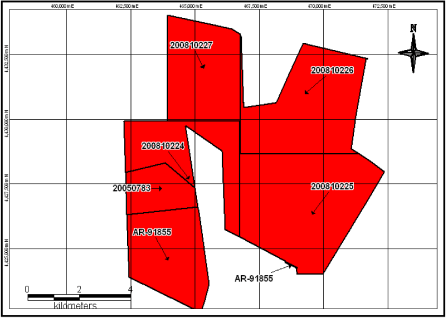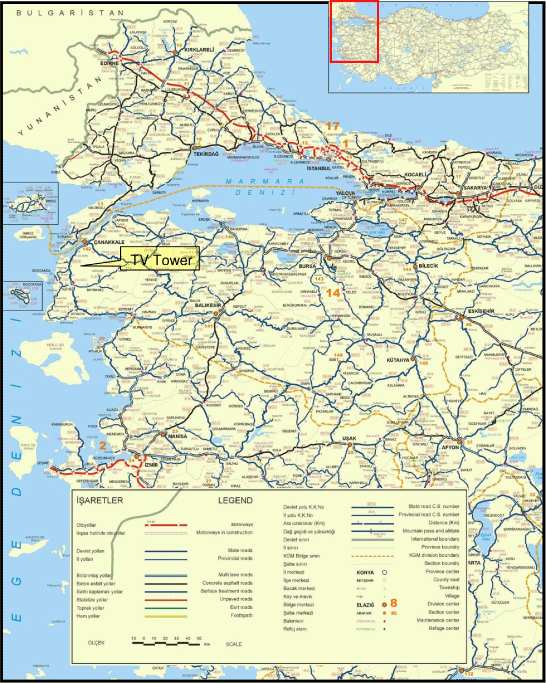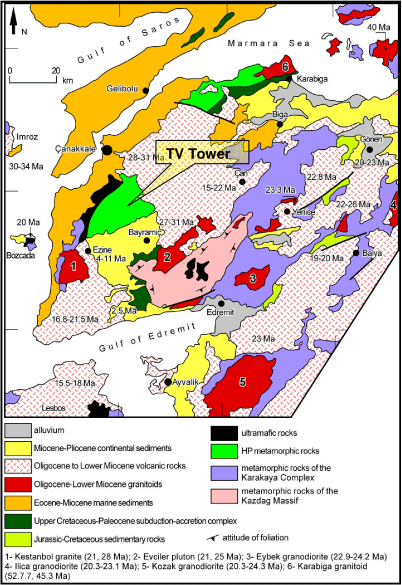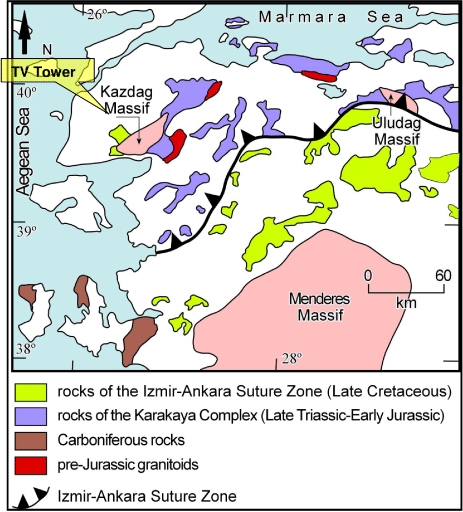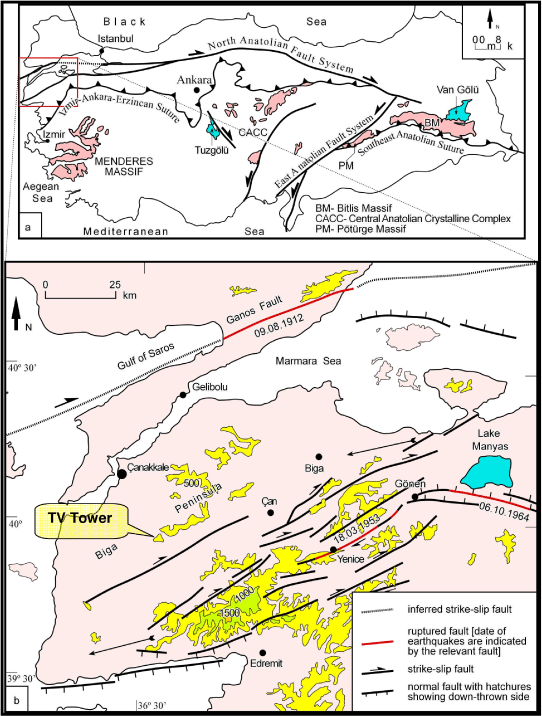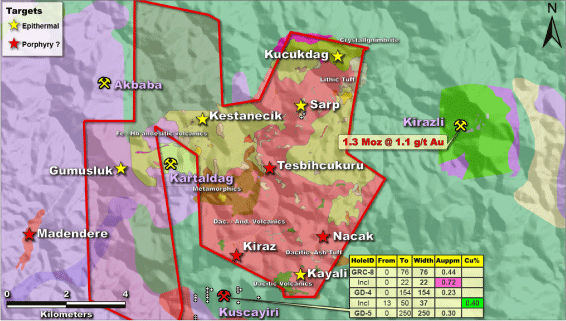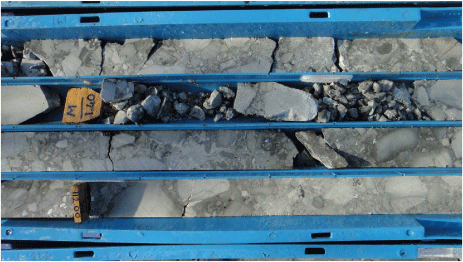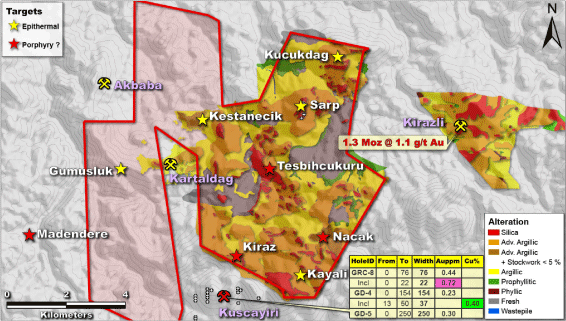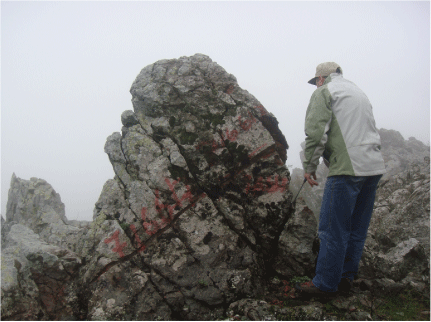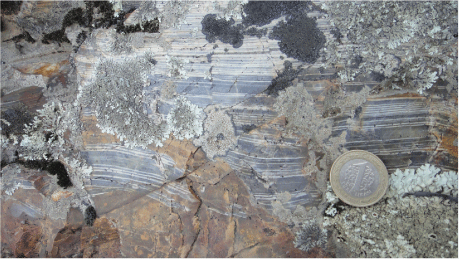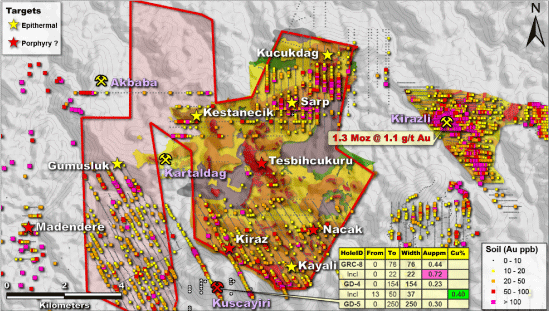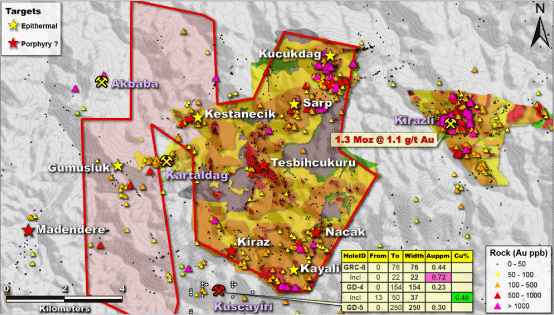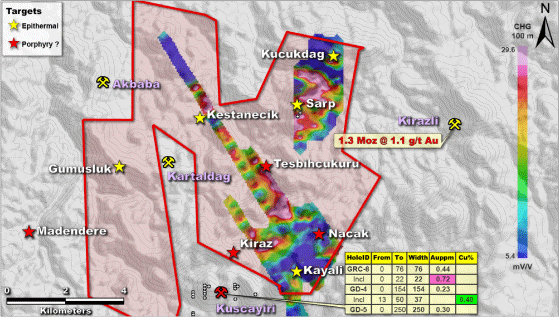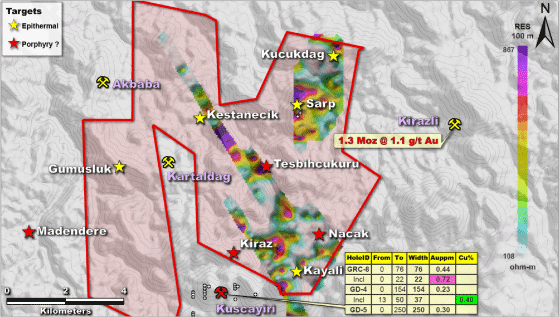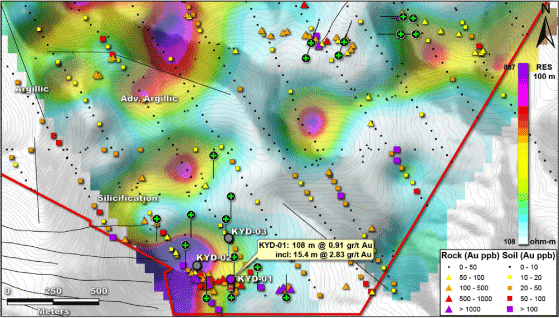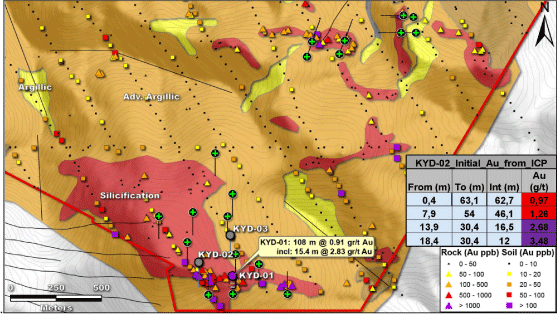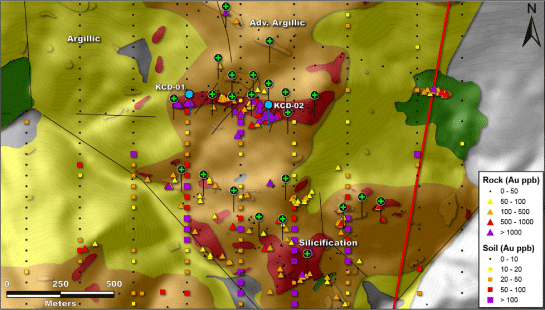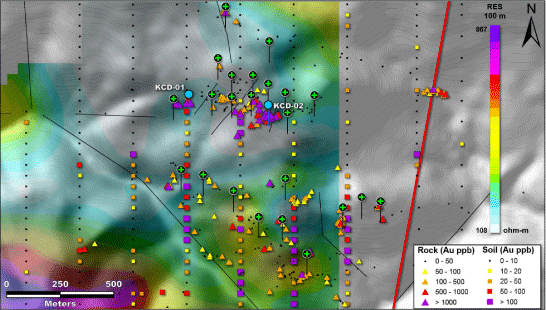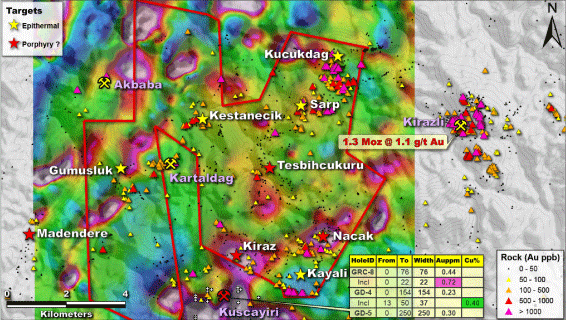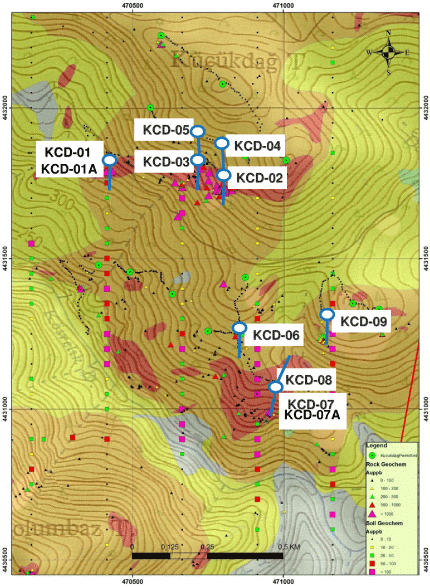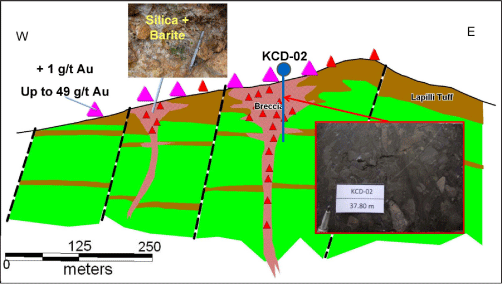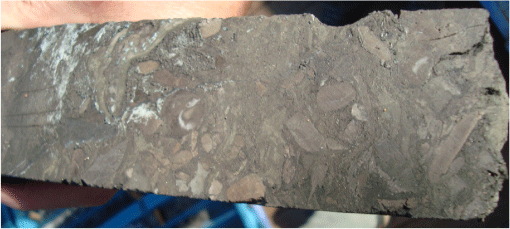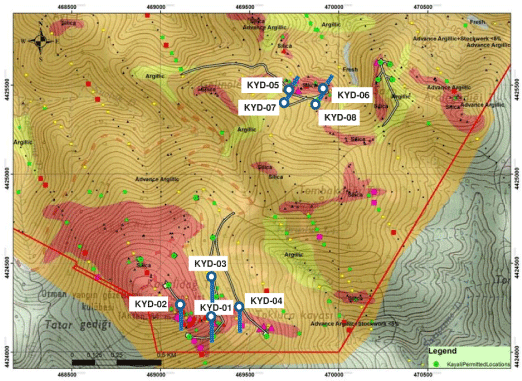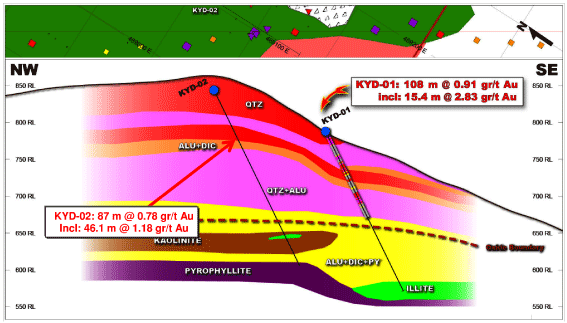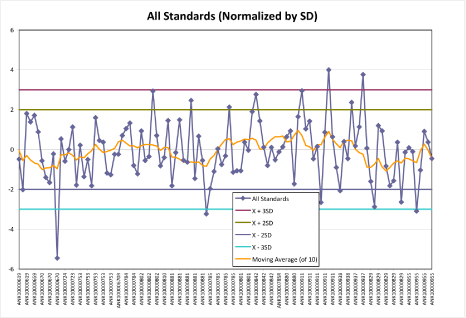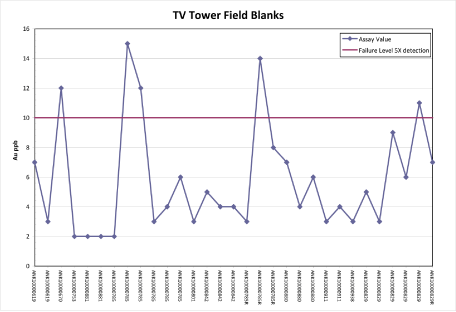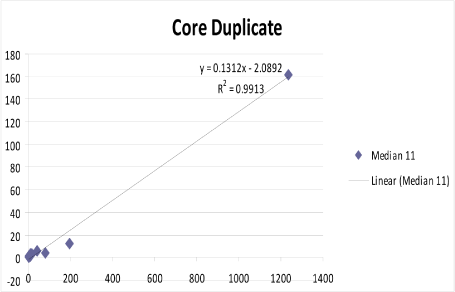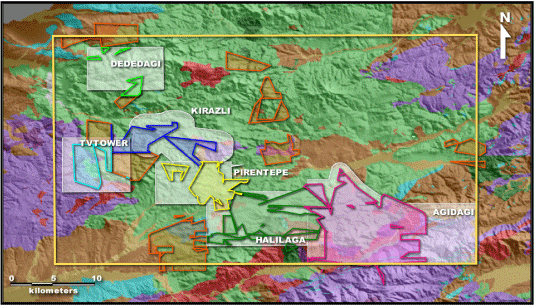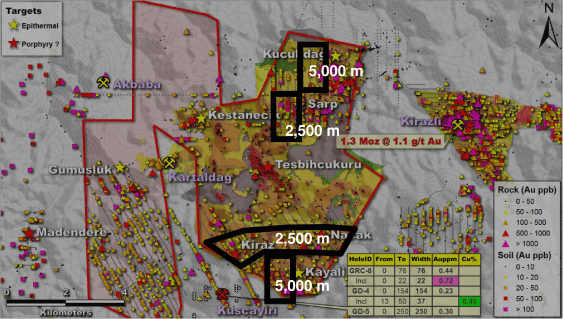NI43-101
TECHNICAL REPORT
ON THE TV TOWER EXPLORATION PROPERTY,
ÇANAKKALE, WESTERN TURKEY
Prepared for:
Suite 1650 — 1055 West Hastings Street
Vancouver, B.C. V6E 2E9
Prepared by:
Ian R. Cunningham-Dunlop, P. Eng.
Submitted in fulfilment of reporting requirements under
National Instrument 43-101
on
February 15, 2011
NI43-101TECHNICAL REPORT ON THE TV TOWER EXPLORATION PROPERTY, ÇANAKKALE, WESTERN TURKEY
Prepared for: Pilot Gold Inc. Suite 1650 — 1055 West Hastings Street Vancouver, B.C. V6E 2E9
| | | | | |
|
Item 2 Table of contents | | | | |
| |
| Item 2 Table of contents | | | 2 | |
| Item 3 Summary | | | 5 | |
| Item 4 Introduction | | | 8 | |
| Item 5 Reliance on Other Experts | | | 9 | |
| Item 6 Property Description and Location | | | 10 | |
| Item 7 Accessibility, Climate, Local Resources, Infrastructure and Physiography | | | 13 | |
| Item 8 History | | | 15 | |
| Item 9 Geological Setting | | | 16 | |
| Item 10 Deposit Types | | | 26 | |
| Item 11 Mineralization | | | 27 | |
| Item 12 Exploration | | | 28 | |
| Item 13 Drilling | | | 36 | |
| Item 14 Sampling Method and Approach | | | 42 | |
| Item 15 Sample Preparation, Analyses and Security | | | 43 | |
| Item 16 Data Verification | | | 46 | |
| Item 17 Adjacent Properties | | | 50 | |
| Item 20 Other Relevant Data and Information | | | 51 | |
| Item 21 Interpretation and Conclusions | | | 54 | |
| Item 22 Recommendations | | | 55 | |
| Item 23 References | | | 57 | |
| Item 24 Date and Signature Pages | | | 58 | |
| Item 25 Additional Requirements for Technical Reports on Development Properties and Production Properties | | | 59 | |
| Item 26 Illustrations | | | 59 | |
NI43-101TECHNICAL REPORT ON THE TV TOWER EXPLORATION PROPERTY, ÇANAKKALE, WESTERN TURKEY
Prepared for: Pilot Gold Inc. Suite 1650 — 1055 West Hastings Street Vancouver, B.C. V6E 2E9
| | | | | |
|
| Appendix I Certificate of Author | | | 60 | |
| Appendix II Glossary of Terms | | | 61 | |
| Appendix III Drilling and sample protocols | | | 64 | |
| | | | | |
LIST OF TABLES | | | | |
| |
| Table 1 TV Tower Land Tenure details as at 1 February, 2011 | | | 10 | |
| Table 2 Budget and details of the TV Tower project by year. | | | 29 | |
| Table 3 Summary of 2010 Drill holes at TV Tower | | | 36 | |
| Table 4 Significant intercepts from the TV Tower property | | | 41 | |
| Table 5 List of gold and standards used at TV Tower | | | 46 | |
| Table 6 List of failed Au standards | | | 47 | |
| Table 7 Indicated and inferred resource of Alamos Gold’s Aği Daği Project | | | 50 | |
| Table 8 Proposed TV Tower Budget for 2011 | | | 55 | |
| | | | | |
LIST OF FIGURES | | | | |
| |
| Figure 1 TV Tower Land Tenure | | | 10 | |
| Figure 2 Location of the TV Tower property, Western Turkey | | | 14 | |
| Figure 3 Simplified geological map of the Biga Peninsula | | | 17 | |
| Figure 4 Simplified geological map of western Turkey | | | 18 | |
| Figure 5(a) Simplified neotectonic map of Turkey | | | 20 | |
| Figure 5(b) Major neotectonic structures of the Biga Peninsula | | | 20 | |
| Figure 6 TV Tower, geology and licences outlined in red | | | 21 | |
| Figure 7 TV Tower Alteration Map | | | 24 | |
| Figure 8 Soil geochemistry and alteration | | | 30 | |
| Figure 9 Rock geochemistry and alteration | | | 30 | |
NI43-101TECHNICAL REPORT ON THE TV TOWER EXPLORATION PROPERTY, ÇANAKKALE, WESTERN TURKEY
Prepared for: Pilot Gold Inc. Suite 1650 — 1055 West Hastings Street Vancouver, B.C. V6E 2E9
| | | | | |
|
| Figure 10 TV Tower I.P. survey, chargeability with targets | | | 32 | |
| Figure 11 TV Tower I.P. survey, resistivity with targets | | | 32 | |
| Figure 12 Kayali target I.P. survey, resistivity with targets and drill holes | | | 33 | |
| Figure 13 Kayali target I.P. survey, alteration with targets and drill holes | | | 33 | |
| Figure 14 Kücükdag alteration with targets and drill holes | | | 34 | |
| Figure 15 Kücükdag target I.P. survey, resistivity with targets and drill holes | | | 34 | |
| Figure 16 TV Tower airborne magnetic survey | | | 35 | |
| Figure 17 DDH Plan Map of Kücükdag Target showing 2010 Drill Holes | | | 37 | |
| Figure 18 Kücükdag ddh cross section showing KCD-02 | | | 38 | |
| Figure 19 DDH Plan Map of Kayali and Nacak Targets showing 2010 Drill Holes | | | 39 | |
| Figure 20 Kayali ddh cross section showing KYD-01 and KYD-02 | | | 40 | |
| Figure 21 Au standard values with 2SD used at TV Tower | | | 46 | |
| Figure 22 Blank results (Au ppm) | | | 48 | |
| Figure 23 Au Duplicates | | | 48 | |
| Figure 24 Location of Aği Daği & Kirazli Projects relative to TV Tower | | | 50 | |
| Figure 25 Location of proposed 2011 Drill Holes totalling 15.000 metres | | | 56 | |
| | | | | |
LIST OF PHOTOS | | | | |
| |
| Photo 1 TV Tower — Looking north from Kayali towards Kücükdag | | | 13 | |
| Photo 2. Tuff Mega Breccia in DDH KCD-02 at Kücükdag | | | 23 | |
| Photo 3 Massive outcropping silica at Kayali Target | | | 25 | |
| Photo 4 Ash tuff from Kücükdag high-grade outcrop area | | | 27 | |
| Photo 5 KCD-02 - heterolithic rounded to sub-angular dickitic breccia | | | 38 | |
NI43-101TECHNICAL REPORT ON THE TV TOWER EXPLORATION PROPERTY, ÇANAKKALE, WESTERN TURKEY
Prepared for: Pilot Gold Inc. Suite 1650 — 1055 West Hastings Street Vancouver, B.C. V6E 2E9
Item 3 Summary
The TV Tower exploration property (“TV Tower”) is located in Çanakkale Province on the Biga Peninsula of North-western Turkey. It is situated 27 kilometres southeast of the city of Çanakkale and 2.6 kilometres north of the village of Kuscayir. Access to the property is afforded by a series of well maintained local and forestry roads.
TV Tower is a 60%-40% joint venture between Teck Madencilik San.Tic.A.S. (“TMST”) and Fronteer Gold Inc. (“Fronteer”) with TMST as the operator. The licenses relating to TV Tower are held by Ortu Truva Madencilik Sanayi Ticaret Limited Sirketi (“Ortu Truva”) which is the legal joint venture entity. Fronteer owns 40% of the share capital of Ortu Truva and TMST owns 60% with the option to elect to earn an additional 10%.
Pursuant to the expected sale of Fronteer to Newmont Mining Company agreement dated February 3, 2011, Fronteer’s 40% interest in Ortu Truva will be transferred in it’s entirety to Pilot Gold Ltd. (“Pilot Gold”), giving Pilot Gold a 40% ownership in TV Tower, as well as, a 40% interest in other individual licenses and groups of licenses within surrounding area. This technical report is limited to the TV Tower group of six licenses situated at 465,870E 4,423,580N UTM Central meridian 27 (ED50 datum) consisting of 6,744.26 hectares of mineral tenure. Four of the six licenses are valid until November 7, 2011, with the remaining two licenses are pending conversion to operations licenses and have no current expiration date.
TV Tower lies within the central part of the Biga Peninsula whose geology is complex and characterized by various lithological associations made up of: (i) basement metamorphic rocks; (ii) Permian and Mesozoic rock units; (iii) ophiolitic rocks, (iv) Tertiary (Eocene) units, (v) Neogene sediments, and (vi) collisional to extensional Tertiary granitoids and associated volcanic rocks.
TV Tower comprises Cretaceous-aged metamorphic basement rocks on the western and eastern edges, and Eocene-sediments, which are intruded by Tertiary-aged intrusives at the southern parts, and overlain by dominantly Neogene-aged calc-alkaline volcanic rocks. These volcanic rocks are typically volcaniclastics (ash-lapilli tuff) which are enveloped by a more coherent feldspar porphyritic unit. They are variably altered, brecciated, mineralized and display a range of intensities of brittle deformation.
NI43-101TECHNICAL REPORT ON THE TV TOWER EXPLORATION PROPERTY, ÇANAKKALE, WESTERN TURKEY
Prepared for: Pilot Gold Inc. Suite 1650 — 1055 West Hastings Street Vancouver, B.C. V6E 2E9
TV Tower is interpreted to contain multiple zones of epithermal gold mineralization nested within what appears to be a large, highly altered volcanic centre. Many of these target areas have wide-spread epithermal alteration with supporting geophysical and geochemical signatures typical of those seen at other high-sulphidation gold and porphyry copper-gold deposits in the Biga region.
The initial target evaluation of TV Tower was conducted by Fronteer staff in the summer of 2008. Subsequent 2009 and 2010 exploration was conducted by TMST and includes:
| | • | | 1:5,000 and 1:10,000 scale detailed geological mapping. |
| |
| | • | | 14.6 line kilometres of IP chargeability / resistivity surveying |
| |
| | • | | 157 line kilometres of ground magnetic surveying |
| |
| | • | | 970 rock-saw/chip samples |
| |
| | • | | 1,543 soil samples |
| |
| | • | | 1,300 PIMA samples |
| |
| | • | | 19 drills holes totaling 4,184 metres on the Kücükdag, Kayali and Nacak targets |
Results from the 2010 drilling at the Kücükdag and Kayali targets were very encouraging and point to the presence of at least two significant high-sulphidation epithermal gold systems on the TV Tower Property. Assay highlights from diamond drilling include:
| | • | | 4.26 g/t Au over 136.20 metres, including12.76 g/t Au over 15.90 metresin KCD-02 |
| |
| | • | | 16.33 g/t Au over 24.20 metresin KCD-03 |
| |
| | • | | 8.2 g/t Au over 8.20 metresand4.54 g/t Au over 13.00 metresin KCD-04 |
| |
| | • | | 0.91 g/t Au over 108.00 metres,including2.83 g/t Au over 15.40 metresin KYD-01 |
| |
| | • | | 0.78 g/t Au over 88.60 metres, including1.18 g/t Au over 46.10 metresin KYD-02 from the Kayali target. |
Both the Kayali and Kücükdag zones are hosted within a sequence of gently-dipping ash and lithic tuffs overprinted by intense silicification development (massive and vuggy). The presence of local dickite/alunite/barite alteration associated with mineralized breccia zones and/or diatremes at Kücükdag appears to be a locus for high-grade mineralization.
NI43-101TECHNICAL REPORT ON THE TV TOWER EXPLORATION PROPERTY, ÇANAKKALE, WESTERN TURKEY
Prepared for: Pilot Gold Inc. Suite 1650 — 1055 West Hastings Street Vancouver, B.C. V6E 2E9
Additional field work will have to be carried out in order gain a structural framework for the Kücükdag target and an understanding of the possible orientation and extent of the breccias.
Other targets on the TV Tower exploration property are equally as compelling for both high-sulphidation gold epithermal mineralization and possible copper-gold porphyry systems so an aggressive campaign is recommended to fully investigate the property.
Given the success of the 2010 program, the following recommendations proposed by TMST (TMST, 2010) for the 2011 program have been reviewed and are supported by the author. The majority of the work is focused on four of the high priority targets; Kücükdag, Sarp, Kiraz and Kayali. Details of the work are:
| | • | | Detailed geological mapping of the TV Tower Licence area with an emphasis on the structural controls of the mineralization at Kücükdag, Sarp, Kiraz and Kayali. |
| |
| | • | | Infill soil geochemistry on 125 metre spaced lines/25 metre samples and 62.5 metre spaced lines/12.5 metre samples over target areas. |
| |
| | • | | Infill IP survey on 125 metre spaced lines over high priority targets; total of 50 line-km. |
| |
| | • | | A 15,000 metre diamond drilling program as follows: |
| | • | | Kücükdag 5,000m |
| |
| | • | | Sarp 2,500m |
| |
| | • | | Kiraz 2,500m |
| |
| | • | | Kayali 5,000m |
| | • | | Continued detailed prospecting, geochemical sampling over the TV Tower licences. |
The total 2011 budget for the above programme as proposed by TMST isUS$3,500,000.The share of this budget to Pilot Gold will beUS$1,568,000(40% of US$3,500,000 plus 12% management fee).
NI43-101TECHNICAL REPORT ON THE TV TOWER EXPLORATION PROPERTY, ÇANAKKALE, WESTERN TURKEY
Prepared for: Pilot Gold Inc. Suite 1650 — 1055 West Hastings Street Vancouver, B.C. V6E 2E9
Item 4 Introduction
This report on the TV Tower Exploration Property has been prepared by Ian R. Cunningham-Dunlop, P. Eng. at the request of Matthew Lennox-King, President of Pilot Gold. This report was commissioned by Pilot Gold to comply with disclosure and reporting requirements set forth in National Instrument 43-101, Companion Policy 43-101CP, and Form 43-101F1, in connection with the spin-out of Pilot Gold from Fronteer as part of the plan of arrangement pursuant to which Newmont Mining Corporation will acquire all of the common shares of Fronteer.
This report, prepared to a 43-101 compliant standard, details the historical and current exploration work at TV Tower in the Çanakkale Province of North-western Turkey. The licenses relating to the TV Tower are held by Ortu Truva, which is the legal joint venture entity set up to hold TV Tower. Fronteer (soon Pilot Gold) owns 40% of the share capital of Ortu Truva and TMST owns 60%. TV Tower forms an important part of Pilot Gold’s properties and activities in the Biga Peninsula of North-western Turkey. Public and private sources of information and data contained in this report, other than the author’s direct observations, are cited in the text and referenced at the end of the report.
The gold values for work performed by Pilot Gold are reported as grams per metric tonne (“g/t”) unless otherwise indicated. Currency is reported in US dollars unless otherwise noted. All map co-ordinates are given as Turkish Co-ordinate System (UTM 6 Degree k=0.9996 — ED50), UTM Central Meridian 27 (ED50) co-ordinates or Latitude/Longitude.
I. R. Cunningham-Dunlop is a qualified person and has worked in his field of expertise for 27 years on gold exploration properties in Canada, United States, Argentina and Turkey. He has been employed by Fronteer since October 22nd, 2004 as Exploration Manager — Canada/Turkey and then Vice President — Exploration and has a thorough knowledge of the recent work on the TV Tower. He supervised the geological field work conducted by Fronteer in 2008 and has been on site during the current exploration programs conducted by TMST; most recently in July and Nov 2010. At the time of writing of this report, the author currently serves as Vice President — Exploration for Fronteer and will take the new position of Chief Operating Officer for Pilot Gold. He is not independent with respect to the business activities of Fronteer or Pilot Gold.
NI43-101TECHNICAL REPORT ON THE TV TOWER EXPLORATION PROPERTY, ÇANAKKALE, WESTERN TURKEY
Prepared for: Pilot Gold Inc. Suite 1650 — 1055 West Hastings Street Vancouver, B.C. V6E 2E9
Item 5 Reliance on Other Experts
A substantial amount of technical data on the exploration work performed on the TV Tower exploration property has been provided by TMST, the 60% owner of the project and current project operator. This material has been distributed to Pilot Gold in the form of quarterly PowerPoint presentations, Excel spreadsheets, and e-mail and personal correspondence and has been used extensively throughout this report to document the ongoing exploration work. This material was prepared by in-house geological staff employed by TMST and also by in-house geological staff employed by TMST’s parent company, Teck Resources Ltd. (“Teck”). Given the reputation of TMST/Teck, and the long standing relationship between Fronteer and TMST/Teck, the author has no reason to doubt the validity of the work and has accepted it a face value.
Where the author has relied on non-qualified persons relating to other issues relevant to this technical report, a statement in the relevant section is made giving the author’s opinion on the validity of the data used and interpretations made.
NI43-101TECHNICAL REPORT ON THE TV TOWER EXPLORATION PROPERTY, ÇANAKKALE, WESTERN TURKEY
Prepared for: Pilot Gold Inc. Suite 1650 — 1055 West Hastings Street Vancouver, B.C. V6E 2E9
Item 6 Property Description and Location
TV Tower is located in Çanakkale Province on the Biga Peninsula of North-western Turkey. It is situated 27 kilometres southeast of the city of Çanakkale and 2.6 kilometres north of the village of Kuscayir at 465,870E 4,423,580N UTM Central meridian 27 (ED50 datum).
The property consists of 6,744.26 hectares of mineral tenure in six contiguous licenses
(Figure 1 and Table 1).
Figure 1. TV Tower Land Tenure (generated by Pilot Gold, 2011).
| | | | | | | | | | | | | | | | | | | | | | | |
| | | | | | | | | | | | | | | | | | | | | | | |
| | | | | | | | | | | | | | | | | | | | | | | APP. DATE |
| | | | | | | | | | | | | | | | | | | | | | | /VALIDUNTIL/ |
| | | | | | | LICENSE | | | | | | | | | | | | | | CONVERSION |
| | | NAME OF | | | | AREA | | ACCESS | | | | | | EXPLORATION | | OWNER | | PAYMENT |
| No | | PROPERTY | | ACQ. DATE | | (Ha) | | NUMBER | | REGISTR. No | | LICENSE NO | | NAME | | DATE |
| 1 | | MERKEZ-YENIKOY | | 18-Apr-05 | | | 422.43 | | | | 3054704 | | | | 20050783 | | | | | TMST | | 18-Apr-10 (pending conversion) |
| 2 | | BAYRAMIC- KAYACIKOB ASI | | 2-Mar-04 | | | 972.36 | | | | 1048473 | | | | 69050 | | | AR-91855 | | TMST | | 2-Mar-09 (pending conversion) |
| 3 | | MERKEZ | | 6-Nov-08 | | | 847.24 | | | | 3185466 | | | | 200810224 | | | | | Ortu Truva | | 7-Nov-11 |
| 4 | | MERKEZ | | 6-Nov-08 | | | 1,490.24 | | | | 3185470 | | | | 200810226 | | | | | Ortu Truva | | 7-Nov-11 |
| 5 | | MERKEZ | | 06-Nov-08 | | | 1,076.14 | | | | 3185468 | | | | 200810227 | | | | | Ortu Truva | | 7-Nov-11 |
| 6 | | MERKEZ | | 06-Nov-08 | | | 1,935.85 | | | | 3185469 | | | | 200810225 | | | | | Ortu Truva | | 7-Nov-11 |
6 | | | | | | | 6,744.26 | | | | | | | | | | | | | | | |
Table 1. TV Tower Land Tenure details as at 1 February, 2011.
NI43-101TECHNICAL REPORT ON THE TV TOWER EXPLORATION PROPERTY, ÇANAKKALE, WESTERN TURKEY
Prepared for: Pilot Gold Inc. Suite 1650 — 1055 West Hastings Street Vancouver, B.C. V6E 2E9
Fronteer’s interest in TV Tower was initiated in 2004 when Fronteer signed a letter of intent with TMST, to acquire a 100% interest in all TMST’s properties in the Biga region (excluding the Agi Dagi and Kirazli properties which were covered by separate agreements). Fronteer completed its technical due diligence and October 19, 2004, signed Letters of Agreement on the Biga Properties.
To earn a 100% interest, Fronteer was required to spend US$2,000,000 from the date of the agreement to November 1, 2008 as follows:
A total of US$200,000 before November 1, 2005
A further US$300,000 before November 1, 2006
A further US$500,000 before November 1, 2007
And a further US$1,000,000 before November 1, 2008 for a cumulative total of US$2,000,000.
Fronteer also issued $105,000 worth of Fronteer shares which equated to 111,930 shares at that time.
TMST retained the right to earn-back a 60% interest in any project that the two parties designated as a “Designated Property” by spending 3.5 times Fronteer’s expenditures on the Designated Property. Halilaga, TV Tower, Dedidagi, Pirentepe were all projects that became Designated properties under this agreement. Fronteer began spending its funds on the broad property package, eventually discovering copper-gold porphyry mineralization at Halilaga, where the bulk of its expenditures were made, followed second by Pirentepe. There was very little expenditure at TV Tower or Dedidagi.
Based on the positive news from Halilaga, TMST exercised its back-in right on all four of the designated properties (including TV Tower) on November 30, 2006 prior to Fronteer completing its US$2,000,000 earn-in. This deemed Fronteer to own them 100% and TMST had to now spend 3.5 times Fronteer’s expenditures. As Fronteer had spent its funds exploring a number of the Biga properties, the deemed expenditure for TV Tower was approx US$33,704. Therefore TMST had to spend only US$US$117,964 at TV Tower to earn a 60% interest. TMST accomplished this in 2007 and the property became a 60%/40% joint venture between TMST and Fronteer. TMST also waived any rights to take their interest to 70%.
NI43-101TECHNICAL REPORT ON THE TV TOWER EXPLORATION PROPERTY, ÇANAKKALE, WESTERN TURKEY
Prepared for: Pilot Gold Inc. Suite 1650 — 1055 West Hastings Street Vancouver, B.C. V6E 2E9
TV Tower is now a 60%-40% joint venture between TMST and Fronteer, with TMST as the operator. The licenses relating to TV Tower are held by Ortu Truva Madencilik Sanayi Ticaret Limited Sirketi (“Ortu Truva”), which is the legal joint venture entity. Fronteer owns 40% of the share capital of Ortu Truva and TMST owns 60%.
Pursuant to the sale of Fronteer to Newmont Mining Company dated February 3, 2011 Fronteer’s 40% interest in Ortu Truva will be transferred in it’s entirety to Pilot Gold Ltd. (“Pilot Gold”), giving Pilot Gold a 40% ownership in TV Tower, as well as, a 40% interest in other individual licenses and groups of licenses as part of the Biga agreement with TMST within the Biga Peninsula area of north-western Turkey.
The author is not aware that the TV property has been surveyed, or that there is a requirement to do so.
Mineralised zones are shown on figures and maps accompanying this report.
The author is not aware that the properties are subject to environmental liabilities other than those attached to drill site permits that have been, or may be issued in the future. There has been no active mining or extensive bulk sampling conducted at TV Tower and therefore, there are limited workings and no existing tailing ponds, waste deposits or other disturbances which could be classified as environmental liabilities on the current TV Tower licences.
As background, Pilot Gold has provided the following information on the requirements to provide an Environmental Impact Assessment (EIA). An EIA must be filed for mining operations at Operation Stage Licenses within the following classes of land: forestry areas, hunting areas, special protection areas, national parks, agricultural areas, cultural protection areas, coastal areas, and tourism areas. The TV Tower property does not lay within any of these special permit areas, therefore an EIA is not required to be lodged until after the drilling stage. Drilling, as defined by the relevant environmental regulations, does not require EIA reporting.
Other than the standard drilling permits, the author is not aware of other any other permits that must be acquired to conduct work proposed on the property.
NI43-101TECHNICAL REPORT ON THE TV TOWER EXPLORATION PROPERTY, ÇANAKKALE, WESTERN TURKEY
Prepared for: Pilot Gold Inc. Suite 1650 — 1055 West Hastings Street Vancouver, B.C. V6E 2E9
Item 7 Accessibility, Climate, Local Resources, Infrastructure and Physiography
The TV Tower property is located 27 kilometres southeast of the city of Çanakkale and 2.6 kilometres north of the village of Kuscayir on the Biga Peninsula, North-western Turkey(Figure 2).Access to the property is afforded by a series of well maintained local and forestry roads.
The property is situated on a topographic high trending in an E-W direction for a distance of 4.5 kilometres. The highest elevations on the property are around ~700 metres.
The Biga Peninsula has fertile soils and a Mediterranean climate with mild, wet winters and hot, dry summers. Temperatures range from 15 to 35 degrees Celsius in the summer season and -10 to 10 degrees Celsius in the winter months. The annual rainfall is approximately 30 centimetres, generally falling as mixed rain and snow in late fall and winter. Year-round access to the properties for field exploration is unrestricted due to weather; however, snow falls during winter may restrict vehicle movement.
The region is well-serviced with electricity, transmission lines and generating facilities, the most significant being a large coal-fired power plant outside the Town of Çan. Population and agricultural activity is concentrated in the valleys, while most areas of active exploration are located in highlands which are predominantly forested.
Local labour is employed from nearby villages. There is no exploration infrastructure located within the properties, with the exception of dirt drill roads.
No assessment of the sufficiency of surface rights for mining operations, the availability and sources of power, water, mining personnel, potential tailings storage areas, potential waste disposal areas, heap leach pad areas and potential processing plant sites has been undertaken as part of this report.
Photo 1. TV Tower — Looking north from Kayali towards Kücükdag.
NI43-101TECHNICAL REPORT ON THE TV TOWER EXPLORATION PROPERTY, ÇANAKKALE, WESTERN TURKEY
Prepared for: Pilot Gold Inc. Suite 1650 — 1055 West Hastings Street Vancouver, B.C. V6E 2E9
Figure 2. Location of the TV Tower property, Western Turkey (Grieve, 2009).
NI43-101TECHNICAL REPORT ON THE TV TOWER EXPLORATION PROPERTY, ÇANAKKALE, WESTERN TURKEY
Prepared for: Pilot Gold Inc. Suite 1650 — 1055 West Hastings Street Vancouver, B.C. V6E 2E9
Item 8 History
Other international mining companies have worked on the TV Tower ground previously. Several holes were drilled on Sarp Dag/Columbaz Tepe in the north-eastern part of the property. Further details regarding this exploration or results from the drilling are not known.
The author is not aware of any previous mineral resource or reserve estimates or mineral production from the property.
NI43-101TECHNICAL REPORT ON THE TV TOWER EXPLORATION PROPERTY, ÇANAKKALE, WESTERN TURKEY
Prepared for: Pilot Gold Inc. Suite 1650 — 1055 West Hastings Street Vancouver, B.C. V6E 2E9
Item 9 Geological Setting
Regional Bedrock Geology
The TV Tower property is located in the central part of the Biga Peninsula in Western Turkey. The geology of the peninsula is complex and characterized by various lithological associations made up of (i) basement metamorphic rocks, (ii) Permian and Mesozoic rock units, (iii) ophiolitic rocks, (iv) Tertiary (Eocene) units, (v) Neogene sediments, (vi) collisional to extensional Tertiary granitoids and associated volcanic rocks(Figure 3). A glossary of terms is included inAppendix II.
Metamorphic rocks occur in three distinct associations:
| | (1) | | The Çamlica metamorphics. These occur as a NE—SW-trending strip of quartz-mica schists (Kemer unit) with calc-schist, quartzite and amphibolite horizons. |
| |
| | (2) | | Kazdağ Massif. The second group of metamorphic rocks is exposed in the Kazdağ mountain range and consists of high-grade metamorphic rocks (amphibole-bearing gneisses with marble intercalations, meta-ophiolite, marble and gneiss). |
| |
| | (3) | | Karakaya Complex. This group comprises two distinct lithologic associations: (a) a strongly deformed greenschist facies metamorphic sequence of metabasites intercalated with phyllite and marble accompanied by minor amounts of metachert, meta-gabbro and serpentinite; and (b) a thick series of low grade metamorphic rocks |
These rocks are, in turn, uncomfortably overlain by weakly deformed Jurassic—Lower Cretaceous sandstones and limestones. The sequence includes: (i) Triassic terrigeneous to shallow marine clastic sedimentary rocks; (ii) Middle to Upper Jurassic platform-type neritic limestones; (iii) Lower Cretaceous pelagic limestones; and (iv) Upper Cretaceous-Palaeocene volcanic and sedimentary rocks.
NI43-101TECHNICAL REPORT ON THE TV TOWER EXPLORATION PROPERTY, ÇANAKKALE, WESTERN TURKEY
Prepared for: Pilot Gold Inc. Suite 1650 — 1055 West Hastings Street Vancouver, B.C. V6E 2E9
Figure 3. Simplified geological map of the Biga Peninsula (Grieve, 2009)
West of the Kazdağ Massif, Late Cretaceous to Palaeocene oceanic accretionary melange tectonically overlies the Kazdağ metamorphic rocks along a low-angle detachment fault / shear zone. The Kazdağ Massif, the shear zone and the accretionary melange are intruded by a late Oligocene pluton. The Çetmi Melange, the Karakaya Complex, the Kazdağ Massif and Jurassic—Lower Cretaceous are unconformably overlain by the Miocene lacustrine sediments and volcanic rocks(Figure 4).All these rocks are, in turn, unconformably overlain by the fluvial and alluvial sediments of Plio—Quaternary age.
NI43-101TECHNICAL REPORT ON THE TV TOWER EXPLORATION PROPERTY, ÇANAKKALE, WESTERN TURKEY
Prepared for: Pilot Gold Inc. Suite 1650 — 1055 West Hastings Street Vancouver, B.C. V6E 2E9
Figure 4. Simplified geological map of western Turkey showing the distribution of Karakaya Complex and the ophiolitic rocks of the Izmir-Ankara suture zone (Grieve, 2009).
Neogene calc-alkaline plutonic and associated volcanic rocks form the most widespread rock units in the Biga Peninsula. The field relations, geochemical and geochronological data suggest that magmatic activity commenced with intrusion(s) of granitoids, coeval with an initial phase of volcanic activity, and continued with a second phase of volcanism. Apart from large plutonic bodies, there are several small-scale granitoid rocks in the region. They were emplaced mostly into the basement metamorphic rocks and associated volcanics and generated well-developed high temperature metamorphic aureoles. The available geochronological data (K-Ar and Rb-Sr ages on mica) suggest that the age of these plutonic rocks ranges from 20.3 to 45.3 Ma, but with a tight cluster between 20.3 and 25.0 Ma.
NI43-101TECHNICAL REPORT ON THE TV TOWER EXPLORATION PROPERTY, ÇANAKKALE, WESTERN TURKEY
Prepared for: Pilot Gold Inc. Suite 1650 — 1055 West Hastings Street Vancouver, B.C. V6E 2E9
The volcanic rocks appear to be associated with plutonic rocks both in space and time. K-Ar and Rb-Sr ages of the volcanic rocks range from 15 Ma to 34 Ma. The Neogene volcanics display two distinct associations which are commonly considered as lower and upper volcanic associations. The lower volcanic association is composed mainly of andesite and dacite lavas, and associated pyroclastic rocks. They are intercalated with the sedimentary rocks. The upper volcanic association is represented by a sequence of andesite, latite, rhyolite, basaltic andesite, basaltic trachyandesite lavas and the associated pyroclastic rocks that alternate with (coal-bearing) lacustrine sediments. The rhyolite occurs as small domes and lavas.
The upper sequence of volcanic rocks is unconformably overlain by coarse- to fine-grained clastic rocks, and lacustrine limestones and mudstones; that were deposited within E—W-trending fault bounded basins.
Regional Structural Geology
The structural geology of the Biga Peninsula is complex and poorly understood. One of the main difficulties arises from the fact that the region is subject to active dextral strike-slip faulting and N—S continental extension. In fact, the region forms a transition between two active tectonic structural styles and many of the active structures reflect the interaction between strike-slip and normal faulting. Nevertheless, the active geologic structures of the region fall, based on their orientation, into three distinct groups: NW—SE faults, NE—SW faults, and E—W faults.
Among these, the most prominent faults are a number of NE—SW-trending dextral strike-slip fault systems that represent the branches of the North Anatolian Fault Zone in the Biga peninsula (e.g., Yenice-Gönen and Etili faults, Figures 5a and 5b). The second group of prominent structures are approximately E—W-trending normal faults. They commonly occur along the northern margin of the Gulf of Edremit and along the southern margin of Lake Manyas. There are less prominent NW—SE-trending faults which are interpreted as synthetic Riedel shears of the North Anatolian Fault Zone.
NE—SW-trending faults controlled both the sedimentation and volcanic activity during the Oligocene—Early Miocene period when the so-called lower volcanic association and coeval sediments were deposited. It is suggested that Late Miocene Ezine alkaline basalts are common along E—W-trending normal faults, thus suggesting a possible feeder relationship.
NI43-101TECHNICAL REPORT ON THE TV TOWER EXPLORATION PROPERTY, ÇANAKKALE, WESTERN TURKEY
Prepared for: Pilot Gold Inc. Suite 1650 — 1055 West Hastings Street Vancouver, B.C. V6E 2E9
Figure5(a). Simplified neotectonic map of Turkey showing major neotectonic structures (After Grieve, 2009).
Figure5(b). Major neotectonic structures of the Biga Peninsula (Grieve, 2009)
NI43-101TECHNICAL REPORT ON THE TV TOWER EXPLORATION PROPERTY, ÇANAKKALE, WESTERN TURKEY
Prepared for: Pilot Gold Inc. Suite 1650 — 1055 West Hastings Street Vancouver, B.C. V6E 2E9
Detailed Geology of the TV Tower Property
Lithology
TV Tower comprises Cretaceous-aged metamorphic basement rocks on the western and eastern edges and Eocene-sediments, which is intruded by Tertiary-aged intrusives at the southern parts, and overlain by dominantly Neogene-aged calc-alkaline volcanic rocks(Figure 6).These volcanic rocks are typically volcaniclastics (ash-lapilli tuff) which are enveloped by more coherent feldspar porphyritic unit. They are variably altered, brecciated, mineralized and display a range of intensities of brittle deformation.
Figure 6. TV Tower, geology and licences outlined in red (TMST, 2010).
Brecciation
A variety of breccias are present at TV Tower. These can be split into numerous categories based on: a) the modes of the fragments; b) the nature of the matrix/cement; and c) the abundance of matrix/cement considered together with the fit of the fragments. There are basically four types of breccia; the distinction based on the composition and diversity of fragments and matrix.
i) Polymict brecciais composed of clasts of different origins embedded within a medium to light grey matrix of milled clasts and clay gouge. The size of clasts ranges from sand to gravel, occasionally larger. Fragments have angular to subrounded shapes with straight to lobate edges and sharp corners.
NI43-101TECHNICAL REPORT ON THE TV TOWER EXPLORATION PROPERTY, ÇANAKKALE, WESTERN TURKEY
Prepared for: Pilot Gold Inc. Suite 1650 — 1055 West Hastings Street Vancouver, B.C. V6E 2E9
One of the most important characteristics of these breccias is the occurrence of dickite veins or vein-like bodies. This reflects at least two phases of hydrothermal alteration. The first phase is characterized by those dickite vein-like structures isolated within the clasts; it suggests fracturing and hydrothermal alteration prior to brecciation. The second phase follows brecciation and is represented by dickite veins crossing through the clasts and/or the matrix of the breccia.
ii) Dickitic brecciais a polymict, matrix-supported breccia composed of variably sized fragments within a dickitic matrix. It comprises vuggy silica, grey silica and dark/black silica fragments. The clasts range from gravel to sand in size and have angular shapes; straight edges and sharp corners are common. It is not clear if the hydrothermal fluids for dickite formation are the cause of brecciation or dickitic alteration/replacement follows brecciation.
iii) Monomict brecciaoccurs in two distinct forms:
Breccia A is a grain-supported breccia characterized by white to creamy silica matrix and dark/black fragments. The fragments still retain their original laminar structure but are intensely silicified. In some, even original grading in grain size is still recognizable. The clasts are rotated as suggested by the variable orientation of the laminar structure in the fragments. Intense silicification of both matrix and clasts is an important feature to note. In some cases, the breccia appears to be constrained between two beds; this may suggest a syn-sedimentary origin for brecciation but more regional evidence is needed for a firm conclusion.
Breccia B is also a grain-supported breccia, characterized by white to creamy silica fragments within a black to dark grey matrix of silica, milled clasts and clay gouge. The fragments are angular and display straight edges and sharp corners. The clasts are mostly larger, gravel or bigger but smaller, even sand sized grains are also present.
It is not clear if the colour of silicification is a reflection of fluid chemistry or composition of the host rock in ‘Breccia A and B’ but they appear to be different. If this approach is valid, then it means two phases of silicification (black vs. creamy) and supports the contention that there are at least two phases of hydrothermal activity, as suggested by dickite occurrences.
NI43-101TECHNICAL REPORT ON THE TV TOWER EXPLORATION PROPERTY, ÇANAKKALE, WESTERN TURKEY
Prepared for: Pilot Gold Inc. Suite 1650 — 1055 West Hastings Street Vancouver, B.C. V6E 2E9
iv) Tuff mega brecciais a clast-supported, poorly sorted, chaotic polymict breccia, composed of angular to subrounded fragments within dark to grey matrix of milled clasts and clay gouge(Photo 2).The size of fragments is variable from sand to gravel, even larger; they are rotated grains and display preserved their original banding and/or bedding. It is a volcaniclastic clast-dominated rock but there are creamy silica fragments as well. As they appear, the rock can be interpreted as diatreme-like tuff breccia but further field-based evidence is required for a better and sound conclusion about the origin of these rocks. Silicification associated with the tuff mega breccia is characteristic.
Photo 2. Tuff Mega Breccia in DDH KCD-02 at Kücükdag.
Alteration
Approximately 2,780 core samples were analyzed with PIMA and the alteration sections were updated. The surface alteration map(Figure 7)was prepared by using data obtained from rock-soil samples PIMA studies.
Alteration characteristics of the Kayali and Kucukdağ target areas can be summarized as follows:
| | • | | Pervasive silicification; massive, vuggy, granular textured(Photo 3). |
| |
| | • | | Silicic alteration; quartz+/-alunite |
| |
| | • | | Advance argillic alteration; dickite+alunite+/-kaolinite +pyrophylite |
| |
| | • | | Argillic alteration; illite+/-smectite+/-sericite+/- kaolinite+/-gypsum |
| |
| | • | | Propylitic alteration; chlorite +/- illite |
NI43-101TECHNICAL REPORT ON THE TV TOWER EXPLORATION PROPERTY, ÇANAKKALE, WESTERN TURKEY
Prepared for: Pilot Gold Inc. Suite 1650 — 1055 West Hastings Street Vancouver, B.C. V6E 2E9
The rocks of TV Tower typically display moderate to intense epithermal style alteration. The silification and advanced argillic alteration (alunite, dickite and pyrophyllite) are the dominant alteration types.
Figure 7. TV Tower Alteration Map (TMST, 2010).
Photo 3. Massive outcropping silica at Kayali Target.
NI43-101TECHNICAL REPORT ON THE TV TOWER EXPLORATION PROPERTY, ÇANAKKALE, WESTERN TURKEY
Prepared for: Pilot Gold Inc. Suite 1650 — 1055 West Hastings Street Vancouver, B.C. V6E 2E9
Structure
The TV Tower area is highly influenced by the presence of structures which relate to or which are part of the North Anatolian Fault System. The general architecture of the faults appears highly controlled by major ENE-WSW trans-tensional structures. Local transpression has been interpreted for the TV Tower area producing the exhumation of the porphyry and older stratigraphy. The ongoing transtensive kinematics have reactivated pre-existing extensional structures. Within this regional transtension regime local restraining and releasing bends and oblique extensional relay ramps could represent key elements which increase structural permeability controlling the emplacement of porphyry, meso- and epithermal mineral deposits (Grieve, 2009).
In December 2010, Structural Geologist Prof. Dr. Erdin BOZKURT visited the project and made some observations. With his observations and comments, the structure of the two main drilling regions at Kayali and Küçükdağ can be explained.
Kayali Area:The outcropping silica at Kayali forms a distinct ledge trending in almost ESE-WNW direction. It is dissected by numerous parallel fractures/joints trending in the same direction. Locally observed bedding planes have an attitude of 025°/50°W. This observation suggests a structural control on silicification rather than a stratigraphic control. When geophysical data, airborne and ground mag, is examined, the anomalies correlate well with the observed orientation (285°/72°S) of the fractures in the Kayali prospect.
Küçükdağ Area:The prominent features are also ESE-WNW-trending structures; they seem to bound the silica ledges and responsible for the topographic relief in their footwall. The faults are typical oblique-slip structures; some show evidence for a dominant dextral strike-slip motion (rake angle ranges between 10° and 16°) whereas others have a dominant normal component (rake angle ranges between 55° and 65°). There also NW-SE-trending structures. The observed bedding planes dip gently northwards; measured planes are 296°/13°N and 310°/27°. There is no correlation between attitude of bedding and observed silica ledge orientations. When geophysical data, airborne and ground mag, is examined, the anomalies correlate well with the observed orientation of the faults in the Küçükdağ prospect.
NI43-101TECHNICAL REPORT ON THE TV TOWER EXPLORATION PROPERTY, ÇANAKKALE, WESTERN TURKEY
Prepared for: Pilot Gold Inc. Suite 1650 — 1055 West Hastings Street Vancouver, B.C. V6E 2E9
Item 10 Deposit Types
The TV Tower exploration property is interpreted to contain multiple zones of gold mineralization nested within what appears to be a large, highly altered volcanic centre. Many of these target areas have wide-spread epithermal alteration with supporting geophysical and geochemical signatures typical of those seen at other high-sulphidation gold (Kirazli, Agi Dagi) and porphyry copper-gold deposits (Halilaga) within the Biga Peninsula.
TV Tower is underlain by volcaniclastics (ash-lapilli tuff)(Photo 4)which is intercalated by more coherent feldspar porphyritic unit. The volcaniclastics (ash-lapilli tuff) has high permeability which makes it more favourable unit for gold mineralization. Post-mineralization normal faulting also controls the geometry of the volcaniclastics (ash+lapilli tuff) unit.
Photo 4. Ash tuff from Kücükdaghigh-grade outcrop area.
NI43-101TECHNICAL REPORT ON THE TV TOWER EXPLORATION PROPERTY, ÇANAKKALE, WESTERN TURKEY
Prepared for: Pilot Gold Inc. Suite 1650 — 1055 West Hastings Street Vancouver, B.C. V6E 2E9
Item 11 Mineralization
To date, seven targets have been defined by a combination of geophysical, geochemical and geological methods. Of the seven targets, four targets are epithermal (Kücükdag, Kayali, Sarp, and Kestancilik) and three are porphyry (Nacak, Tesbihcukuru, and Kiraz). At present, the focus of activity for TMST is the Kücükdag and Kayali/Nacak targets as described below.
Kücükdag targetis located in the northern part of TV Tower property. The area is underlain by a sequence of gently north-dipping agglomerate to fine volcaniclastics that are overlain by intensely silicified felsic ash tuff and ash-lapilli tuff, with ignimbritic volcanics at higher elevations and more coherent feldspar porphyry at lower elevations. Rare laminated tuffaceous volcanic rocks are intercalated with coherent feldspar porphyries, particularly on the upper part of the Küçükdağ,
A broad 750 m x 100 m zone of strong silcification is present at the Kücükdag target. The geochemical sampling suggests that the gold mineralization is related to multi-phase breccias which cut through the volcaniclastic sequence. The extent and dimensions of this breccia development is unknown at this time.
Surface rock sampling has returned a high of ~50 g/t Auand also up to100 ppm Ag. The pathfinder elements are indicative of an epithermal gold system and are anomalous in Ba, Sb, As, and Ga.
Kayali/Nacak targetis situated in the southern portion of the TV Tower property. Two different sequences of lapilli tuffaceous units were defined during the geology-alteration mapping: a coherent feldpsar porphyritic unit intercalated with the lapilli tuff; and a highly silicified lapilli tuff unit which is well-exposed at Kayali hill.
The Kayali target includes extensive outcropping high-sulphidation-type silicification and a strong advance argillic-argillic alteration pattern over a 2 km x 1.5 km area. Gold mineralization is hosted mainly by an E-W trending structure zone within the highly silicified lapilli tuff unit and rock sample results have returned highly encouraging values in the range of1 to ~10 g/t Auwith rock channel samples.
The Nacak target is located 2 km to the northeast of Kayali with a similar lithology-alteration and mineralization pattern and anomalous surface rock sampling to2.3 g/t Au over 3.8 metres.
NI43-101TECHNICAL REPORT ON THE TV TOWER EXPLORATION PROPERTY, ÇANAKKALE, WESTERN TURKEY
Prepared for: Pilot Gold Inc. Suite 1650 — 1055 West Hastings Street Vancouver, B.C. V6E 2E9
Item 12 Exploration
Historic Exploration
The government General Directorate of Mineral Research and Exploration of Turkey (MTA) conducted a regional scale exploration programme over the Biga Peninsula between 1988—1991.
Other international mining companies have held the TV Tower ground previously. Several holes were drilled on Sarp Dag/Columbaz Tepe in the NE part of the property. Further details regarding this exploration are not known.
In 1996 and 1997, TMST collected 36 rock samples from silicified and argillicly altered outcrops along with six silt samples. The highest grade rock samples returned 1900 ppb and 510 ppb Au at Sarp and the highest silt sample returned 241ppb Au from the south eastern portion of the property. These anomalous results highlighted the potential of the area.
Recent Exploration
Initial target evaluation was conducted by Fronteer in early 2008 prior to the acquisition of four of the six licenses from government auction in September 2008. The initial data collected by Fronteer is consistent with modern 43-101 procedures.
The 2008-2010 exploration work was conducted by TMST and author has relied on data and information relating to exploration work and results conducted during 2009 and 2010 supplied by TMST, and is satisfied that the data and information was collected in a proper manner and collated into appropriate databases. This work includes:
2008
| | • | | Reconnaissance mapping and prospecting |
| |
| | • | | Geochemistry surveying: 316 Rock samples, 96 silt samples,(Table 2). |
2009
| | • | | 1:5,000 and 1:10,000 scale detailed geological mapping |
| |
| | • | | 25 line-km of ground Mag (Kayali and Kücükdag targets) |
| |
| | • | | 1315 soil samples |
| |
| | • | | 485 rock-saw channel samples (1.5 km total length); sampling defined significant outcropping gold mineralization including74m @ 1.3 g/t Au at Kayaliand1.9m @ 11 g/t Au at Nacak. |
| |
| | • | | 1300 PIMA samples. |
NI43-101TECHNICAL REPORT ON THE TV TOWER EXPLORATION PROPERTY, ÇANAKKALE, WESTERN TURKEY
Prepared for: Pilot Gold Inc. Suite 1650 — 1055 West Hastings Street Vancouver, B.C. V6E 2E9
| | • | | 650 Hand specimens for magnetic susceptibility measurements |
| |
| | • | | Seven targets were defined by geochemical results and mapping (Kücükdag, Kayali, Sarp, Kestancilik, Nacak, Tesbihcukuru, Kiraz) |
2010
| | • | | Detailed geological/alteration/mineralization mapping (Kücükdag, Sarp, Kayali, and Nacak) |
| |
| | • | | 132 line-km detailed ground Mag (Kayali, Sarp, Kücükdag. |
| |
| | • | | 14.6 line-km IP (Kayali, Kücükdag, Sarp) |
| |
| | • | | 228 Soil samples |
| |
| | • | | 485 rock samples |
| |
| | • | | Three targets at drill testing stage (Kayali, Nacak and Kücükdag) |
| |
| | • | | 19 diamond drill holes totaling 4,184 metres |
A summary of work completed by Fronteer and TMST during the 2005-2010 period can be found belowTable 2.Total expenditures to date are US$1,832,428.
| | | | | | | | | | | | | | | | | | | | | | | | | | | | | |
| TV TOWER | | 2005 | | | 2006 | | | 2007 | | | 2008 | | | 2009 | | | 2010 | | | Total | |
| Total Geochem Sample | | | 69.0 | | | | 305.0 | | | | 1,497.0 | | | | 952.0 | | | | 2,279.0 | | | | 702.0 | | | | 5,804.0 | |
| IP/Resistivity (Line Km) | | | — | | | | — | | | | — | | | | — | | | | 25.2 | | | | 39.2 | | | | 64.4 | |
| Ground Magnetic Survey (Line Km) | | | — | | | | — | | | | — | | | | — | | | | | | | | 168.0 | | | | 168.0 | |
| Total Drill Holes | | | — | | | | — | | | | — | | | | — | | | | | | | | 19.0 | | | | 19.0 | |
| Drilling (meters) | | | — | | | | — | | | | — | | | | — | | | | | | | | 4,183.6 | | | | 4,183.6 | |
| Budget (US $) | | | 5,490.00 | | | | 8,818.00 | | | | 93,773.00 | | | | 18,505.00 | | | | 141,671.00 | | | | 1,564,171.00 | | | | 1,832,428.00 | |
Table 2. Budget and details of the TV Tower project by year.
NI43-101TECHNICAL REPORT ON THE TV TOWER EXPLORATION PROPERTY, ÇANAKKALE, WESTERN TURKEY
Prepared for: Pilot Gold Inc. Suite 1650 — 1055 West Hastings Street Vancouver, B.C. V6E 2E9
Geochemistry
A total of 1,543 soil samples were collected on 250 metres spaced lines and 50 metre spaced stations. The soil and rock sampling n the TV Tower property serves to highlight a number of zones of anomalism as seen inFigures 8 and 9which were corroborated by follow-up mapping.The detailed soil grids also highlight the relative impermeable nature of the silica cap at Kayali with stronger gold anomalies around the edges of the cap.
Figure 8. Soil geochemistry and alteration (TMST, 2010)
Figure 9. Rock geochemistry and alteration (TMST, 2010)
NI43-101TECHNICAL REPORT ON THE TV TOWER EXPLORATION PROPERTY, ÇANAKKALE, WESTERN TURKEY
Prepared for: Pilot Gold Inc. Suite 1650 — 1055 West Hastings Street Vancouver, B.C. V6E 2E9
Geophysical Surveys
IP/Chargeability
64 line kilometres of IP Chargeability/ Resistivity surveying were conducted at TV Tower from 2009 to 2010.
The IP survey(Figures 10/11/12/13/14/15)highlights a number of pre-existing showings. Currently the most significant targets are Kücükdag and Kayali; both have strong chargeability highs with adjacent resistivity highs. Kücükdag contains a higher percentage of sulphides and has been less weathered (oxidized) than Kayali and has a strong ~300m wide chargeability and an adjacent — but offset, resistivity high which correlates to the silica alteration.
Magnetics
168 line kilometres of ground magnetic surveying were conducted at TV Tower from 2009 to 2010.
The historic airborne surveying and recent follow-up ground magnetic surveying(Figure 16)have identified several “bulls-eye” mag highs which have a general NE trend and seem to follow the regional structural fabric. Although rotated to the north these large scale structures likely reflect the transtensional structures during the Oligocene—Early Miocene of the North Anatolian Fault system. The less prominent NW—SE-trending faults, e.g. the valley and break in the magnetic feature between Kiraz and Nacak, are interpreted as minor splays of synthetic Riedel shears related to the North Anatolian Fault Zone. The NW-SE features may play an important function as dilation zones and therefore locus of magmatic activity. Each “bulls-eye” features in conjunction with the surface geology and geochemistry constitutes a potential porphyry target. Presently only Kücükdag, Sarp and Kayali have had in-depth follow-up work completed.
NI43-101TECHNICAL REPORT ON THE TV TOWER EXPLORATION PROPERTY, ÇANAKKALE, WESTERN TURKEY
Prepared for: Pilot Gold Inc. Suite 1650 — 1055 West Hastings Street Vancouver, B.C. V6E 2E9
Figure 10. TV Tower I.P. survey, chargeability with targets (TMST, 2010).
Figure 11. TV Tower I.P. survey, resistivity with targets (TMST, 2010).
NI43-101TECHNICAL REPORT ON THE TV TOWER EXPLORATION PROPERTY, ÇANAKKALE, WESTERN TURKEY
Prepared for: Pilot Gold Inc. Suite 1650 — 1055 West Hastings Street Vancouver, B.C. V6E 2E9
Figure 12. Kayali target I.P. survey, resistivity with targets and drill holes
(completed are solid, crosses are proposed) (TMST, 2010).
Figure 13. Kayali target I.P. survey, alteration with targets and drill holes
(completed are solid, crosses are proposed) (TMST, 2010).
NI43-101TECHNICAL REPORT ON THE TV TOWER EXPLORATION PROPERTY, ÇANAKKALE, WESTERN TURKEY
Prepared for: Pilot Gold Inc. Suite 1650 — 1055 West Hastings Street Vancouver, B.C. V6E 2E9
Figure 14. Kücükdag target, alteration with targets and drill holes
(completed are solid, crosses are proposed) (TMST, 2010).
Figure 15. Kücükdag target I.P. survey, resistivity with targets and drill holes
(completed are solid, crosses are proposed) (TMST, 2010).
NI43-101TECHNICAL REPORT ON THE TV TOWER EXPLORATION PROPERTY, ÇANAKKALE, WESTERN TURKEY
Prepared for: Pilot Gold Inc. Suite 1650 — 1055 West Hastings Street Vancouver, B.C. V6E 2E9
Figure 16. TV Tower airborne magnetic survey,
with targets and rock geochemistry (TMST, 2010)
NI43-101TECHNICAL REPORT ON THE TV TOWER EXPLORATION PROPERTY, ÇANAKKALE, WESTERN TURKEY
Prepared for: Pilot Gold Inc. Suite 1650 — 1055 West Hastings Street Vancouver, B.C. V6E 2E9
Item 13 Drilling
Drilling commenced at the TV Tower property on August 23, 2010 and was completed on January 5, 2011.19 holes (including 2 abandoned holes) totalling 4,183.60 metreswere completed during the 2010 season(Table 3).
| | | | | | | | | | | | | | | | | | | | | | | | | | | | | |
| AREA | | DRILL | | | UTM COORDINATES | | | | | | | | | | | | | |
| (ZONE) | | HOLE# | | | EASTING | | | NORTHING | | | AZIMUTH | | | DIP | | | TD (m) | | | COMMENT | |
| Kayali | | KYD-01 | | | 469285 | | | | 4424205 | | | | 180 | | | | -60 | | | | 250.00 | | | COMPLETED |
| Kayali | | KYD-02 | | | 469105 | | | | 4424270 | | | | 180 | | | | -60 | | | | 274.80 | | | COMPLETED |
| Kayali | | KYD-03 | | | 469281 | | | | 4424416 | | | | 180 | | | | -60 | | | | 265.90 | | | COMPLETED |
| Kayali | | KYD-04 | | | 469432 | | | | 4424265 | | | | 180 | | | | -60 | | | | 187.20 | | | COMPLETED |
| Nacak | | KYD-05 | | | 469725 | | | | 4425479 | | | | 25 | | | | -60 | | | | 249.00 | | | COMPLETED |
| Nacak | | KYD-06 | | | 469911 | | | | 4425488 | | | | 20 | | | | -60 | | | | 194.10 | | | COMPLETED |
| Nacak | | KYD-07 | | | 469704 | | | | 4425393 | | | | 25 | | | | -60 | | | | 217.80 | | | COMPLETED |
| Nacak | | KYD-08 | | | 469875 | | | | 4425417 | | | | 20 | | | | -60 | | | | 192.20 | | | COMPLETED |
| Kücükdag | | KCD-01 | | | 470425 | | | | 4431830 | | | | 180 | | | | -60 | | | | 135.00 | | | ABANDONED |
| Kücükdag | | KCD-01A | | | 470429 | | | | 4431830 | | | | 180 | | | | -60 | | | | 162.00 | | | COMPLETED |
| Kücükdag | | KCD-02 | | | 470790 | | | | 4431780 | | | | 180 | | | | -70 | | | | 245.00 | | | COMPLETED |
| Kücükdag | | KCD-03 | | | 470710 | | | | 4431830 | | | | 170 | | | | -70 | | | | 260.60 | | | COMPLETED |
| Kücükdag | | KCD-04 | | | 470795 | | | | 4431879 | | | | 180 | | | | -70 | | | | 251.10 | | | COMPLETED |
| Kücükdag | | KCD-05 | | | 470724 | | | | 4431920 | | | | 180 | | | | -70 | | | | 230.10 | | | COMPLETED |
| Kücükdag | | KCD-06 | | | 470861 | | | | 4431248 | | | | 180 | | | | -60 | | | | 255.20 | | | COMPLETED |
| Kücükdag | | KCD-07 | | | 470976 | | | | 4431085 | | | | 200 | | | | -60 | | | | 48.30 | | | ABANDONED |
| Kücükdag | | KCD-07A | | | 470977 | | | | 4431086 | | | | 200 | | | | -60 | | | | 175.00 | | | COMPLETED |
| Kücükdag | | KCD-08 | | | 470964 | | | | 4431074 | | | | 35 | | | | -60 | | | | 240.00 | | | COMPLETED |
| Kücükdag | | KCD-09 | | | 471144 | | | | 4431302 | | | | 180 | | | | -55 | | | | 350.30 | | | COMPLETED |
| | | | | | | | | | | | | | | | | | | Total (m)= | | | | 4,183.60 | | | | | |
| | | | | | | | | | | | | | | | | | | Abandoned (m) | | | | 183.30 | | | | | |
| | | | | | | | | | | | | | | | | | | Total (m)= | | | | 4,000.30 | | | | | |
Table 3. Summary of 2010 Drill holes at TV Tower.
The main objective of the 2010 drilling program was to test the coincident geophysical anomalies and anomalous gold values in both the rock and soil samples at the Kayali, Nacak and Kücükdag targets. These are described in the following sections.
Kücükdag Target
A total of 11 diamond drill holes totalling 2,352.60 metres were drilled at Kücükdag(Figure 17). Six holes were southerly-directed into the shallow north-dipping volcaniclastic sequence and were designed to follow-up on strong anomalous surface rock sample results(up to ~50 g/t Au).The remaining four holes were testing a strong gold-in-soil anomaly a further 500 metres to the southeast.
NI43-101TECHNICAL REPORT ON THE TV TOWER EXPLORATION PROPERTY, ÇANAKKALE, WESTERN TURKEY
Prepared for: Pilot Gold Inc. Suite 1650 — 1055 West Hastings Street Vancouver, B.C. V6E 2E9
Figure 17. DDH Plan Map of Kücükdag Target showing 2010 Drill Holes (TMST, 2010)
Three of the six holes directed towards the northern target returned very encouraging intercepts which included:4.26 g/t Au over 136.20 metres, including12.76 g/t Au over 15.90 metresin Hole KCD-02,16.33 g/t Au over 24.20 metresin KCD-03, and8.2 g/t Au over 8.20 metres and4.54 g/t Au over 13.00 metresin KCD-04. The mineralization is hosted within ash and lithic tuff and is characterized by intense silicification (massive and
NI43-101TECHNICAL REPORT ON THE TV TOWER EXPLORATION PROPERTY, ÇANAKKALE, WESTERN TURKEY
Prepared for: Pilot Gold Inc. Suite 1650 — 1055 West Hastings Street Vancouver, B.C. V6E 2E9
vuggy) with local dickite/alunite/barite cut by sulphized fractures, faults, and heterolithic breccia zones and/or diatremes(Figure 18 and Photo 1). Sulphides occur within 10-20 metres of surface and consist of locally up to 10% pyrite with 5-10% chalcocite and possible enargite (?).
Results for holes KCD-05 to KCD-09 are still pending receipt from TMST.
Figure 18. Kücükdag ddh cross section showing KCD-02,
with structural interpretation and mineralization, (TMST, 2010).
Photo 5. KCD-02 — heterolithic rounded to sub-angular dickitic breccia,
with fine-grained sulphides, dickite (white) and alunite (tan) alteration.
NI43-101TECHNICAL REPORT ON THE TV TOWER EXPLORATION PROPERTY, ÇANAKKALE, WESTERN TURKEY
Prepared for: Pilot Gold Inc. Suite 1650 — 1055 West Hastings Street Vancouver, B.C. V6E 2E9
Kayali Target
A total of four diamond drill holes totalling 977.90 metres were drilled at Kayali(Figure 19). The holes were designed to strong outcropping silicfication with anomalous rock sampling to10 g/t Au.
Figure 19. DDH Plan Map of Kayali and Nacak Targets showing 2010 Drill Holes (TMST, 2010).
Results have been returned for holes KYD-01 and KYD-02 and both returned long runs of promising epithermal gold mineralization starting at or near surface. This includes:0.91 g/t Au over 108.00 metres,including2.83 g/t Au over 15.40 metresin KYD-01 and0.78 g/t Au over 88.60 metres, including1.18 g/t Au over 46.10 metres in KYD-02.
Mineralization is hosted within intensely silicified (massive and vuggy) ash and lithic tuff cut by narrow iron-stained fractures and faults. Oxidation depth is deep and averages 100-200 metres(Figure 20).
Results for holes KYD-03 and KYD-04 are still pending receipt from TMST.
NI43-101TECHNICAL REPORT ON THE TV TOWER EXPLORATION PROPERTY, ÇANAKKALE, WESTERN TURKEY
Prepared for: Pilot Gold Inc. Suite 1650 — 1055 West Hastings Street Vancouver, B.C. V6E 2E9
Figure 20. Kayali ddh cross section showing KYD-01 and KYD-02,
with alteration interpretation and intersection highlights (TMST, 2010)
Nacak Target
A total of four diamond drill holes totalling 853.10 metres were drilled at Nacak(Figure 19). The holes were designed to test outcropping silification and anomalous surface rock sampling to2.3 g/t Au over 3.8 metres.
Results for drill holes KYD-05 to KYD-09 are still pending receipt from TMST.
Composite results for holes KCD-02/03/04 and KYD-01/02 can be found inTable 4on the following page. Only Au values have been reported by TMST to Pilot Gold.
NI43-101TECHNICAL REPORT ON THE TV TOWER EXPLORATION PROPERTY, ÇANAKKALE, WESTERN TURKEY
Prepared for: Pilot Gold Inc. Suite 1650 — 1055 West Hastings Street Vancouver, B.C. V6E 2E9
| | | | | | | | | | | | | | | | | | | | | |
| | | | | | | From | | | To | | | | | | | |
| Hole No. | | Zone | | | (m) | | | (m) | | | Interval | | | Au (g/t) | |
KCD-02 | | Kucukdag | | | 12.3 | | | | 148.5 | | | | 136.2 | | | | 4.26 | |
Incl | | | | | | | 44.8 | | | | 112 | | | | 67.2 | | | | 8.23 | |
Incl | | | | | | | 54.2 | | | | 101.5 | | | | 47.3 | | | | 11.13 | |
Incl | | | | | | | 54.2 | | | | 70.1 | | | | 15.9 | | | | 12.76 | |
Incl | | | | | | | 59.6 | | | | 64.1 | | | | 4.5 | | | | 25.57 | |
Incl | | | | | | | 83.6 | | | | 88.3 | | | | 4.7 | | | | 30.57 | |
Incl | | | | | | | 100.4 | | | | 101.5 | | | | 1.1 | | | | 82.2 | |
KCD-03 | | Kucukdag | | | 44.4 | | | | 51.7 | | | | 7.3 | | | | 0.52 | |
And | | | | | | | 78.2 | | | | 102.4 | | | | 24.2 | | | | 16.33 | |
Incl | | | | | | | 79.3 | | | | 90.5 | | | | 11.2 | | | | 26.52 | |
Incl | | | | | | | 79.3 | | | | 84.6 | | | | 5.3 | | | | 37.92 | |
Incl | | | | | | | 80.5 | | | | 81.35 | | | | 0.85 | | | | 50.78 | |
And | | | | | | | 139.9 | | | | 152.9 | | | | 13 | | | | 0.36 | |
KCD-04 | | Kucukdag | | | 48.5 | | | | 56 | | | | 7.5 | | | | 1.28 | |
And | | | | | | | 135.9 | | | | 139.8 | | | | 3.9 | | | | 1.99 | |
And | | | | | | | 155 | | | | 163.2 | | | | 8.2 | | | | 4.09 | |
Incl | | | | | | | 156.9 | | | | 158 | | | | 1.1 | | | | 22.6 | |
And | | | | | | | 200.6 | | | | 213.6 | | | | 13 | | | | 4.54 | |
Incl | | | | | | | 203.1 | | | | 204 | | | | 0.9 | | | | 23.5 | |
Incl | | | | | | | 209.8 | | | | 210.6 | | | | 0.8 | | | | 16.2 | |
KYD-01 | | Kayali | | | 4.5 | | | | 119 | | | | 114.5 | | | | 0.87 | |
Incl | | | | | | | 5.7 | | | | 113.7 | | | | 108 | | | | 0.91 | |
Incl | | | | | | | 5.7 | | | | 21.1 | | | | 15.4 | | | | 2.83 | |
Incl | | | | | | | 38.7 | | | | 43.6 | | | | 4.9 | | | | 2.04 | |
Incl | | | | | | | 96.1 | | | | 113.7 | | | | 17.6 | | | | 1.12 | |
Incl | | | | | | | 103.6 | | | | 113.7 | | | | 10.1 | | | | 1.41 | |
KYD-02 | | Kayali | | | 0.4 | | | | 89 | | | | 88.6 | | | | 0.78 | |
Incl | | | | | | | 7.9 | | | | 89 | | | | 81.1 | | | | 0.84 | |
Incl | | | | | | | 7.9 | | | | 54 | | | | 46.1 | | | | 1.18 | |
Incl | | | | | | | 18.4 | | | | 30.4 | | | | 12 | | | | 3,23 | |
Table 4. Significant intercepts from the TV Tower property
(Estimated true widths are 60% to 90%of intersected widths)
(Results for holes KCD-05 to KCD-09 and KYD-03 to KYD-09 are still pending).
NI43-101TECHNICAL REPORT ON THE TV TOWER EXPLORATION PROPERTY, ÇANAKKALE, WESTERN TURKEY
Prepared for: Pilot Gold Inc. Suite 1650 — 1055 West Hastings Street Vancouver, B.C. V6E 2E9
Item 14 Sampling Method and Approach
All drill samples collected were subjected to quality control procedures that ensured best practice in the handling, sampling, analysis and storage of the drill core. All drill holes were sampled and assayed continuously. Sample intervals were selected on a geological basis. Core was cut length-wise with half the core being submitted for assaying.
No factors related to drilling, sampling or recoveries are known that would materially impact the accuracy and reliability of the results.
A summary of composites with values and estimated true widths is presented inTable 4.
Sampling protocols are given inAppendix II.
NI43-101TECHNICAL REPORT ON THE TV TOWER EXPLORATION PROPERTY, ÇANAKKALE, WESTERN TURKEY
Prepared for: Pilot Gold Inc. Suite 1650 — 1055 West Hastings Street Vancouver, B.C. V6E 2E9
Item 15 Sample Preparation, Analyses and Security
Core Drilling and Logging
Spektra Jeoteck Sanayi Ve Ticaret Anonim Sirketi of Turkey was contracted for the drilling. Drilling commenced at TV Tower on August 23, 2010 and was completed on January 5, 2010. 19 diamond holes totalling 4,183.60 metres were completed during that period(Table 3).
All proposed drill collars were surveyed using a theodolite total station. Control was relative to established survey points across the property. Drills were set up under the direct supervision of TMST staff.
Drill holes were collared in HQ diameter core (63.5 millimetres). The holes were reduced to NQ (47.6 millimetres) when problems were encountered due to bad ground conditions/thick fault zones. Core was placed in plastic boxes with depth markers every drill run (up to 3 metres).
Boxes were securely sealed and brought to the core facility at the Etili camp once a day by the drilling company. Reflex survey tests were taken generally at 50 metres intervals down-hole to provide control.
Drill Core Sampling
All samples collected were subjected to a quality control procedure that ensured a best practice in the handling, sampling, analysis and storage of the drill core. All drill holes were sampled and assayed continuously. Samples intervals were selected on a geological basis. Core was cut length-wise with half the core being submitted for assaying.
Drill Core Sample Preparation and Security
Samples of drill core were cut by a diamond blade rock saw, with half of the sawn core placed in individual sealed cloth bags and half placed back in the original core box. The retained core is stored in the same facility in the town of Etili.
Shipping
Samples were sent to the Acme Analytical Laboratories Ltd. prep lab in Izmir, Turkey for sample preparation. The coarse reject material was bagged and stored.
NI43-101TECHNICAL REPORT ON THE TV TOWER EXPLORATION PROPERTY, ÇANAKKALE, WESTERN TURKEY
Prepared for: Pilot Gold Inc. Suite 1650 — 1055 West Hastings Street Vancouver, B.C. V6E 2E9
After these samples were processed, the pulps were sent by an independent transport to Acme Analytical Laboratories Ltd., Canada. Rejects and pulps are stored at on site at the Etili camp core shack.
Notification of receipt of sample shipments by the laboratory is confirmed by electronic mail. No problems were encountered in transport during the program.
Sample Preparation
Sample prep occurred at the Acme Analytical Laboratories Ltd. facility in Izmir, Turkey. Sample prep method R200-1000 which includes the coarse crushing of the entire core sample, riffle splitting to approximately 1000 grams, and pulverization of this material in a LM-2 disk mill. An approximately 100 gram pulp packet will be forwarded to Acme-Vancouver for analysis and assay, with the remaining ‘master pulp’ material for each sample remaining in Ankara.
Sample Analyses
Sample analysis occurred at the Acme Analytical Laboratories Ltd. facility in Vancouver, B.C., Canada.
Geochemical Analysis – Group 1DX 01 suite (aqua regia digestion/ICP-MS).
| | • | | This ICP-MS package provides superior detection limits for several elements (for example As, Sb, Hg and Bi) compared to conventional ICP-ES. It also provides S data. It is a more economical version of Acme’s ultratrace ICP-MS method, suitable for rock and core analysis. |
| |
| | • | | This method uses a 0.5 gram sample weight, which is adequate here – for core -as a gold fire assay (30 gram split; see below) is also being carried out on each sample. |
Gold Fire Assay – Group 3B01 method
| | • | | This fire assay method uses a 30 gram sample split with ICP finish. Gold is reported to a detection limit of 2 ppb. |
| |
| | • | | The method is for Au concentrations < 10 g/t; samples reporting higher Au concentrations should be re-assayed using Acme’s Group 6 fire assay method. |
Base Metal Assay – Group 7TD02 method
| | • | | This base metal total assay method uses a strong 4-acid digestion (Group 7TD) followed by an ICP finish. The full-suite Group 7TD02 method provides assay |
NI43-101TECHNICAL REPORT ON THE TV TOWER EXPLORATION PROPERTY, ÇANAKKALE, WESTERN TURKEY
Prepared for: Pilot Gold Inc. Suite 1650 – 1055 West Hastings Street Vancouver, B.C. V6E 2E9
| | | | data for 23 elements, including Cu, Mo, Ag and Fe, rather than for just Cu as with the previous ALS Chemex AAS assay method. |
| |
| | • | | Typically a slightly cheaper aqua regia digestion/AAS assay method would be suitable for the assay of porphyry-style Cu mineralization. However in this case, the 4-acid digestion assay method is to be used as it is part of the protocol for the sequential Cu assay of the supergene blanket at Halilaga. |
Base Metal Assay — Sequential Cu Leach – Group 9 04 Sequential Cu leach
| | • | | Should be requested, by special instruction on analytical request sheets, for all core intersections with visible supergene Cu mineralization. Presumably this will only affect a relatively small proportion of core samples submitted. |
| |
| | • | | The Gp 9 04 method includes three sequential leaches, including the total Cu assay of the residual component. In addition, a total Cu assay is to be done on a separate sample split. In Acme-Santiago, where the sequential leaches will be conducted, the Group 8TD method (4-acid digestion/AAS) is used for total Cu assay. |
The Acme Labs sequential leach process includes the following procedures, the first three of which are done on a single sample split:
| | • | | Group 9 04 sulfuric acid leach |
| |
| | • | | Group 9 04 cyanide leach |
| |
| | • | | Group 9 04 total Cu on residual(Gp 8TD 4-acid digestion/AAS) |
| |
| | • | | Group 8TD total Cu on a separate sample split (4-acid digestion/AAS) |
Acme Analytical Laboratories Ltd. operates according to the guidelines set out in ISO/IEC Guide 25 – “General requirements for the competence of calibration and testing laboratories”.
NI43-101TECHNICAL REPORT ON THE TV TOWER EXPLORATION PROPERTY, ÇANAKKALE, WESTERN TURKEY
Prepared for: Pilot Gold Inc. Suite 1650 – 1055 West Hastings Street Vancouver, B.C. V6E 2E9
Item 16 Data Verification
Quality control measures and data verification procedures applied to the acquisition of drill data including alteration, assay, collar, lithologies, magnetics, mineralization, recovery, and surveying is contained in Appendix III.
The author has relied on data and information relating to quality assurance and control that has been prepared by a person who is a Qualified Person as defined in NI43-101. This data was prepared by in-house technical personnel for Teck Resources Ltd. in Vancouver, B.C., Canada.
Standards
Commercial standards sourced from CDN Resource Laboratories Ltd were used to test the accuracy of the assays and to monitor the consistency of the laboratory. These standards were inserted into the sample sequences approximately every 20 samples.
A total of 109 standards for Au were analyzed during the 2010 drill program. CDN – gold standards gold standards were chosen to use in data verification(Table 5).The results of these analyses are presented inFigure 21.
There were five failed standards or 4.5%(Table 6). This is a higher than normal failure rate in the standards and the field duplicates. TMST are talking to the lab to be more rigorous with cleaning in the prep lab and their Chief Geochemist is looking into other more suitable methods for analysis for coarse gold (i.e. pulp/metallic screening methods) to help reduce failure levels.
The five failed batches were re-run on the existing pulp and passed on the second try.
| | | | | | | | | | | | | |
| STANDARDID | | Au g/t | | | 2SD | | | 1SD | |
CDN-GS-1P5A | | | 1.37 | | | | 0.12 | | | | 0.06 | |
CDN-GS-2B | | | 2.03 | | | | 0.12 | | | | 0.06 | |
CDN-GS-5C | | | 4.74 | | | | 0.28 | | | | 0.14 | |
CDN-GS-P3A | | | 0.338 | | | | 0.022 | | | | 0.011 | |
CDN-GS-P8 | | | 0.78 | | | | 0.06 | | | | 0.03 | |
Table 5. List of gold and standards used at TV Tower (TMST, 2010)
NI43-101TECHNICAL REPORT ON THE TV TOWER EXPLORATION PROPERTY, ÇANAKKALE, WESTERN TURKEY
Prepared for: Pilot Gold Inc. Suite 1650 — 1055 West Hastings Street Vancouver, B.C. V6E 2E9
Figure 21. Au standard values with 2SD used at TV Tower (TMST, 2010)
| | | | | | | | | | | | | | | | | | | | | | | | | | | | | |
| Failed Standards, 2010 | |
| | | | | | | | | | | | | | | ASSAY | | | | | | | | | | |
| | | | | | | | | | | STANDARD | | | VALUE Au | | | ACCEPTABLE | | | ACCEPTABLE | | | STANDARD | |
| STANDARD ID | | ASSAY NAME | | CHECKID | | | VALUE Au ppb | | | ppb | | | MIN Au ppb | | | MAX Au ppb | | | DEVIATION | |
| CDN-GS-2B | | Au_3B_ACVE_ppb | | | 750219 | | | | 2030 | | | | 1703 | | | | 1850 | | | | 2210 | | | | 60 | |
| CDN-GS-1P5A | | Au_3B_ACME_ppb | | | 751145 | | | | 1370 | | | | 1176 | | | | 1190 | | | | 1550 | | | | 60 | |
| CDN-GS-P8 | | Au_3B_ACME_ppb | | | 751995 | | | | 780 | | | | 900 | | | | 690 | | | | 870 | | | | 30 | |
| CDN-GS-1P5A | | Au_3B_ACME_ppb | | | 780103 | | | | 1370 | | | | 1596 | | | | 1190 | | | | 1550 | | | | 60 | |
| CDN-GS-P3A | | Au_3B-ACVE_ppb | | | 781039 | | | | 338 | | | | 304 | | | | 305 | | | | 371 | | | | 11 | |
Table 6. List of failed Au standards (TMST, 2010)
Blanks
Non-mineralized limestone and commercial CDN blank BL-03 were inserted into the sample series every 20 samples(Figure 22).All results fell within acceptable limits.
Duplicates
Duplicate samples are used to monitor sample batches for potential mix-ups and monitor the data variability as a function of both laboratory error and sample homogeneity. The duplicate samples are 1/4 spilt cores done on site before the sample leaves camp. Duplicate field samples are taken every 20 samples within the sample series(Figure 23).All results fell within acceptable limits.
NI43-101TECHNICAL REPORT ON THE TV TOWER EXPLORATION PROPERTY, ÇANAKKALE, WESTERN TURKEY
Prepared for: Pilot Gold Inc. Suite 1650 — 1055 West Hastings Street Vancouver, B.C. V6E 2E9
Figure 22. Blank results (Au ppm)(TMST, 2010)
Figure 23. Au Duplicates (TMST, 2010)
Check Assay
Given the early stage of exploration on the TV Tower project, TMST has not yet initiated a protocol to send 5% of all assayed sample pulps to a second laboratory for analysis.
NI43-101TECHNICAL REPORT ON THE TV TOWER EXPLORATION PROPERTY, ÇANAKKALE, WESTERN TURKEY
Prepared for: Pilot Gold Inc. Suite 1650 — 1055 West Hastings Street Vancouver, B.C. V6E 2E9
QA/QC Problems and Solutions
Most of the diamond drill holes were completed using HQ size core and recovery was not an issue except in fault zones.
Standards and blanks were checked upon receipt of each job and included in an AcQuire database from which QA/QC plots were generated to ensure they were with-in limits. Any failures were recorded and the lab requested to re-run the batch.
The author considers the adequacy of sampling, security and analytical procedures carried out by TMST to be satisfactory with the exception of a lack of check assays being conducted as per the sampling protocol.
NI43-101TECHNICAL REPORT ON THE TV TOWER EXPLORATION PROPERTY, ÇANAKKALE, WESTERN TURKEY
Prepared for: Pilot Gold Inc. Suite 1650 — 1055 West Hastings Street Vancouver, B.C. V6E 2E9
Item 17 Adjacent Properties
One adjacent property (as a result of contiguous license holdings) which contains significant mineralisation of a similar style to TV Tower are the Aği Daği & Kirazli Projects of Alamos Gold Inc. approximately 40 kilometres to the south east(Figure 24).
Aği Daği & Kirazli were previously subject to a Joint Venture between TMST and Fronteer but were sold on January 6, 2010 to Alamos Gold Inc. for US$40 million cash and an aggregate of 4 million Alamos common shares in total consideration to Teck (as to 60%) and Fronteer (as to 40%).
The Alamos Gold Inc. website describes the Aği Daği & Kirazli Projects as high-sulphidation epithermal gold and silver deposits.
Contained resources are stated as being:
| | | | | | | | | | | | | | | | | | | | | | | | | | | | | | | | | | | | | | | | | |
| | | Indicated | | | Inferred | |
| | | Tonnage | | | Au Grade | | | | | | | Ag Grade | | | | | | | Tonnage | | | Au Grade | | | Au Content | | | Ag Grade | | | | |
| Deposit | | tonnes | | | g/t | | | Au Content oz | | | g/t | | | Ag Content oz | | | tonnes | | | g/t | | | oz | | | g/t | | | Ag Content oz | |
| Baba | | | 26,601,000 | | | | 0.52 | | | | 445,000 | | | | 0.60 | | | | 513,000 | | | | 9,898,000 | | | | 0.48 | | | | 153,000 | | | | 5.00 | | | | 159,000 | |
| Deli | | | 25,362,000 | | | | 0.67 | | | | 546,000 | | | | 5.96 | | | | 4,860,000 | | | | 7,970,000 | | | | 1.17 | | | | 300,000 | | | | 11.18 | | | | 2,865,000 | |
| Kirazli | | | 11,831,000 | | | | 0.83 | | | | 316,000 | | | | 13.92 | | | | 5,295,000 | | | | 8,574,000 | | | | 0.65 | | | | 179,000 | | | | 15.93 | | | | 4,391,000 | |
| Total | | | 63,794,000 | | | | 0.64 | | | | 1,307,000 | | | | 5.20 | | | | 10,668,000 | | | | 26,442,000 | | | | 0.74 | | | | 632,000 | | | | 8.72 | | | | 7,415,000 | |
Table 7. Indicated and inferred resource of Alamos Gold’s Aği Daği Project.
Further details of the Aği Daği Project can be found on Alamos website under Aği Daği Project 43-101, (J Keane, 2010).
Figure 24. Location of Aği Daği & Kirazli Projects relative to TV Tower (TMST, 2010).
NI43-101TECHNICAL REPORT ON THE TV TOWER EXPLORATION PROPERTY, ÇANAKKALE, WESTERN TURKEY
Prepared for: Pilot Gold Inc. Suite 1650 — 1055 West Hastings Street Vancouver, B.C. V6E 2E9
Item 20 Other Relevant Data and Information
The author is not aware of any additional information necessary to make the technical report more understandable, nor is he aware of any omissions or inclusions that could be misleading.
As background to the new Turkish mining laws enacted in 2011, the following includes the current land tenure holding laws which have remained the same since 2007.
Mining rights and title in Turkey
Mining rights and minerals are exclusively owned by the state. The ownership of the minerals in Turkey is not subject to the ownership of the relevant land. The State, under the mining legislation, delegates its rights to explore and operate to individuals or legal entities by issuing licences for a determined period of time in return for a payment of royalty. Mining rights with respect to certain types of mines, however, belong to state or state enterprises.
The licences for mining rights are granted to the Turkish citizens, legal entities established under Turkish laws and some authorized public bodies. Companies established under Turkish law according to the provisions of the Turkish Commercial Code are Turkish companies even if they are established by foreign persons with a 100% foreign capital. Consequently, there is not any distinction between the mining rights that may be acquired by local investors and those that may be acquired by foreign investors provided that the foreign investors establish a company in Turkey under Turkish law (Ozkan, 2007).
Under the Turkish Mining Law, mines have been divided into five (5) groups which are subject to different terms and conditions on licensing principals and procedures.
According to Article 6 of the Mining Law, mining rights can be defined as the licenses and permits for prospecting and operating mines and can only be granted to the following real or legal persons; (i) Turkish citizens; (ii) legal entities incorporated under the laws of the Republic of Turkey, including legal entities having foreign shareholders, provided that the articles of association of such legal entities shall contain a mining operation clause; and (iii) authorized public entities and administrative bodies.
The three (3) types of licenses granted for prospecting and operating the mines stated under the laws of the Republic of Turkey are as follows; (i)prospecting license, enabling
NI43-101TECHNICAL REPORT ON THE TV TOWER EXPLORATION PROPERTY, ÇANAKKALE, WESTERN TURKEY
Prepared for: Pilot Gold Inc. Suite 1650 — 1055 West Hastings Street Vancouver, B.C. V6E 2E9
its holder to carry out prospecting activities in a specific area; (ii)operation license, enabling its holder to carry out operational activities within the same area as stated in the prospecting license; and (iii)operation permit, enabling its holder to operate a specific mine as specified in the operation license.
Prospecting activities can be defined as all mining activities other than those carried out for production. As an exception, the prospecting licensee shall have a right to carry out production and sale activities in respect of maximum 10% of the proved mine reserves within the prospecting license period in the event the prospecting licensee applies to the General Directorate of Mining Affairs (Maden lsleri Genel Mudurlugu) with the prospecting activity report.
Terms and Procedure for Prospecting License: The application for prospecting license shall be made to the General Directorate of Mining Affairs for the mining groups other than group I (a). For the group I (a) mines the application shall be made to the relevant Provincial Special Administration (Il Ozel Idaresi). Prospecting licensees are obliged to submit a prospecting activity report to the General Directorate of Mining Affairs within two (2) years upon the obtainment of such license, as provided in Annex 5 of the Regulation on the Implementation of Mining Law. In case of non compliance with such provision, the prospecting license guarantee provided by the prospecting licensee shall be recorded as revenue. The term of the prospecting license is three (3) years and may be extended for a period of two (2) years upon the demand and submission of the second prospecting activity report by the prospecting licensee.
Operation License
Terms: Operation license may only be obtained if the prospecting activities are carried initially. The operation license shall be granted to the prospecting licensee for the proved, potential and feasible mine reserve area determined during the prospecting period for a period of at least ten (10) years upon the evaluation of the aforementioned documents by the General Directorate of Mining Affairs. The term of the operation license may be extended for at least three (3) years upon the application of the holder of the prospecting License and operation license with a new operation project however, such term cannot exceed sixty (60) years. The Council of Ministers is authorized to grant an extension more than sixty (60) years.
NI43-101TECHNICAL REPORT ON THE TV TOWER EXPLORATION PROPERTY, ÇANAKKALE, WESTERN TURKEY
Prepared for: Pilot Gold Inc. Suite 1650 — 1055 West Hastings Street Vancouver, B.C. V6E 2E9
Procedure: The operation licensee must apply to the General Directorate of Mining Affairs to obtain necessary permits stipulated under Article seven (7) of the Mining Law within three (3) months commencing as of the issuance date of the operation license. In case the operation licensee fails to apply to the General Directorate of Mining Affairs within the said period, the guarantee shall be recorded as revenue and a further period of three (3) months shall be provided to the operation licensee for application. If non compliance continues within the additional three (3) months period, the operation license shall be revoked. Thereafter, within fifteen (15) days as of the issuance date of the permits required, the operation licensee is granted an operation permit. Such permit is granted only for the proved mine reserves area which is determined during the prospecting period. Operation activities must be started to be carried out within one (1) year commencing as of the date of the operation permit. In case the operation activities do not commence within such one (1) year period, 10% of the production amount shall be paid as the state right for each year of inactivity. The terms of the aforementioned necessary permits and an operation permit shall be the same as the term of an operation license and in case an extension is granted to an operation license, the term of such permits too shall be extended accordingly.
The Law Regarding Amendments on Mining Law and other Certain Laws, numbered 5995 has been approved by the Grand National Assembly of Republic of Turkey on June 10, 2010 but has not been put into force yet. The effective date of such law has been stated as its publication date on the Official Gazette (Kayikçi, 2010).
NI43-101TECHNICAL REPORT ON THE TV TOWER EXPLORATION PROPERTY, ÇANAKKALE, WESTERN TURKEY
Prepared for: Pilot Gold Inc. Suite 1650 — 1055 West Hastings Street Vancouver, B.C. V6E 2E9
Item 21 Interpretation and Conclusions
The results of the field exploration program carried out by TMST in 2008-2009 and culminating in the Phase 1 drilling program in 2010 are very encouraging and point to the presence of at least two significant high-sulphidation epithermal gold systems on the TV Tower Property.
The results from holes KYD-01 and KYD-02 at the Kayali target demonstrate long widths of epithermal gold mineralization starting from surface((0.87 g/t Au over 114.5 m in holde KYD-01 and 0.91 g/t Au over 108.00 min hole KYD-02), which are consistent with the gold values returned from the preliminary rock saw channel sampling in the same vicinity (1.3 g/t Au over 74.00 min channels). The association of this mineralization with an extensive massive to vuggy silicification lithocap suggests a high-sulphidation style of mineralization. Of particular note, is the deep level of oxidation at Kayali averaging 100-200 metres in thickness.
More importantly, the results from KCD-02/03 at Kücükdag demonstrate the potential for high-grade mineralization at TV Tower. Hole KCD-02 returned4.26 g/t Au over 136.20 metres, including12.76 g/t Au over 15.90 metres,while KCD-03 returned16.33 g/t Au over 24.20 metres. This mineralization is hosted within a shallow dipping sequence of highly silicified ash and lithic tuffs similar to the Kayali target but the presence of possible diatreme-related sulphidized heterolithic breccias with associated dickite/alunite/barite alteration is particularly significant. Additional field work will have to be carried out in order gain a structural framework for the Kücükdag target and an understanding of the possible orientation and extent of the breccias.
Other targets on the TV Tower exploration property are equally as compelling for both high-sulphidation gold epithermal mineralization and possible copper-gold porphyry systems consequently an aggressive campaign is recommended to fully investigate the property.
NI43-101TECHNICAL REPORT ON THE TV TOWER EXPLORATION PROPERTY, ÇANAKKALE, WESTERN TURKEY
Prepared for: Pilot Gold Inc. Suite 1650 — 1055 West Hastings Street Vancouver, B.C. V6E 2E9
Item 22 Recommendations
The following recommendations have been proposed by TMST, the project operator, for the 2011 programme (TMST, 2010) and have been reviewed and are supported by the author. The majority of the work is focused on the high priority targets (Kücükdag, Sarp, Kiraz and Kayali) and includes:
| | • | | Detailed geological mapping of the TV Tower Licence area, with an emphasis on the structural controls of the mineralization at Kücükdag, Sarp, Kiraz and Kayali. |
| |
| | • | | Infill soil geochemistry on 125 metre spaced lines with detailed 62.5 metre spaced lines over target areas. |
| |
| | • | | Infill IP surveying on 125 metres spaced lines over high priority targets (total of 50 line-km) |
| |
| | • | | A 15,000 metres of diamond drilling (Figure 25): |
| | | | | | | |
|
| | | Kücükdag | | | 5,000m | |
| | | Sarp | | | 2,500m | |
| | | Kiraz | | | 2,500m | |
| | | Kayali | | | 5,000m | |
| | • | | Continued prospecting and geochemical sampling over the remainder of licences. |
The total budget for the above programme isUS$3,500,000as shown below. Pilot Gold’s share of this budget will beUS$1,568,000(40% of US$3,500,000 plus Pilot Gold’s share of a 12% management fee on the total).
| | | | | |
| Activity | | Cost USD$ | |
Wages | | | 300,000 | |
Environmental | | | 180,000 | |
Metallurgy | | | 50,000 | |
Total Drilling | | | 2,200,000 | |
Field Support | | | 180,000 | |
Property | | | 100,000 | |
Geophysics | | | 40,000 | |
Assaying & Geochemistry | | | 450,000 | |
TOTAL COSTS (USD) | | | 3,500,000 | |
Table 8. Proposed TV Tower Budget for 2011 (TMST, 2010)
NI43-101TECHNICAL REPORT ON THE TV TOWER EXPLORATION PROPERTY, ÇANAKKALE, WESTERN TURKEY
Prepared for: Pilot Gold Inc. Suite 1650 — 1055 West Hastings Street Vancouver, B.C. V6E 2E9
Figure 25. Location of proposed 2011 Drill Holes totalling 15.000 metres (TMST, 2010).
NI43-101TECHNICAL REPORT ON THE TV TOWER EXPLORATION PROPERTY, ÇANAKKALE, WESTERN TURKEY
Prepared for: Pilot Gold Inc. Suite 1650 — 1055 West Hastings Street Vancouver, B.C. V6E 2E9
Item 23 References
Grieve, P.L., 2007 NI43-101 Technical report on the Pirentepe and Halilağa Properties, Çanakkale, Western Anatolia, Turkey, March 2007
Grieve, P.L., 2009 NI43-101 Technical report on the Halilağa Exploration Property, Çanakkale, Western Turkey, March 2009
Keane, J. , 2010 NI43-101 TECHNICAL REPORT on the AĞI DAĞI-KIRAZLI GOLD PROJECT, ÇANAKKALE PROVINCE, REPUBLIC OF TURKEY, March 2010
Özkan, A., 2007 Turkish Mining Law
Teck Madencilik San.Tic.A.S., 2010 PowerPoint presentations, Excel files, E-mail and Personal Correspondence.
NI43-101TECHNICAL REPORT ON THE TV TOWER EXPLORATION PROPERTY, ÇANAKKALE, WESTERN TURKEY
Prepared for: Pilot Gold Inc. Suite 1650 — 1055 West Hastings Street Vancouver, B.C. V6E 2E9
Item 24 Date and Signature Pages
This technical report in its original form is dated February 15th, 2011 as shown on the title and signature pages as attached. The dates of subsequent revisions, if any, will be recorded on the title page and in this section.
Respectfully submitted at VANCOUVER, B.C., Canada by:
| | | | | |
| | |
| “Ian Cunningham-Dunlop”(signed) | |
| Ian R. Cunningham-Dunlop, P. Eng. | |
Vice President, Exploration
Fronteer Gold Inc. | |
NI43-101TECHNICAL REPORT ON THE TV TOWER EXPLORATION PROPERTY, ÇANAKKALE, WESTERN TURKEY
Prepared for: Pilot Gold Inc. Suite 1650 — 1055 West Hastings Street Vancouver, B.C. V6E 2E9
Item 25 Additional Requirements for Technical Reports on Development Properties and Production Properties
The property subject to this report is not at a development or production stage.
Item 26 Illustrations
Illustrations, photographs, maps, and charts are included within the text in appropriate context. Unless otherwise stated, the Illustration, map, or chart was prepared by TMST and included in this report with permission.
NI43-101TECHNICAL REPORT ON THE TV TOWER EXPLORATION PROPERTY, ÇANAKKALE, WESTERN TURKEY
Prepared for: Pilot Gold Inc. Suite 1650 — 1055 West Hastings Street Vancouver, B.C. V6E 2E9
Appendix I Certificate of Author
I,Ian R. Cunningham-Dunlop, P. Eng., do hereby certify that:
| | 1) | | I am a geologist residing at 2519 Swinburne Avenue, North Vancouver, B.C. V7H 1L6. |
| |
| | 2) | | I graduated with the degree of Bachelor of Applied Science (Geological Engineering) from Queen’s University, Kingston, Ontario, in 1984. |
| |
| | 3) | | I am a member of the Association of Professional Engineers of Ontario (PEO — Reg. No. 10161503), the Association of Professional Engineers and Geoscientists of B.C (APEGBC — Reg. No. 27221)¸ Prospectors and Developers Association of Canada, and the Canadian Institute of Mining and Metallurgy, |
| |
| | 4) | | I have worked as a geologist for a total of 27 years since my graduation. |
| |
| | 5) | | I have read the definition of “qualified person” set out in National Instrument 43-101 (“NI432-101”) and certify that by reason of my education, affiliation with professional associations (as deemed in NI43-101) and past relevant work experience, I fulfill the requirements to be a “qualified person” for the purposes of NI 43-101. |
| |
| | 6) | | I assisted in the preparation of all Sections of the Technical Report titled“Technical Report on the TV Tower Exploration Property, Canakkale, Western Turkey” relating to the TV Tower Exploration Property. I have worked on the property in a technical capacity since 2008, personally supervised the 2008 summer evaluation work, and have made numerous visits to the property in the period 2008-2010 to review the work being carried out by the current operator Teck Madencilik San.Tic.A.S. |
| |
| | 7) | | As of February 15th, 2011 and to the best of my knowledge, information and belief, the Technical Report contains all scientific and technical information that is required to be disclosed to make the technical report not misleading and I have read the disclosure being filed and it fairly and accurately represents the information in the Technical Report that supports the disclosure. |
| |
| | 8) | | I am not aware of any material fact or material change with respect to the subject matter of the Technical Report that is not reflected in the Technical Report, the omission to disclose which make the Technical Report misleading. |
| |
| | 9) | | I am not independent of the issuer applying all the tests in Section 1.5 of National Instrument 43-101 and acknowledge that I hold securities of the Fronteer Gold Inc. as common shares and also in the form of a stock option agreement. |
| |
| | 10) | | I have read National Instrument 43-101 and Form 43-101F1, and the Technical Report has been prepared in compliance with that instrument and form. |
| |
| | 11) | | I consent to the filing of the Technical Report with any stock exchange and other regulatory authority and any publication by them, including electronic publication in the public company files on their websites accessible by the public, of the Technical Report. |
Dated this 15th day of February, 2011 in Vancouver, B.C.
| | | | | |
| | |
| “Ian Cunningham-Dunlop”(signed) | |
| Ian R. Cunningham-Dunlop, P. Eng. | |
Vice President,Exploration
Fronteer Gold. Inc. | |
| |
NI43-101TECHNICAL REPORT ON THE TV TOWER EXPLORATION PROPERTY, ÇANAKKALE, WESTERN TURKEY
Prepared for: Pilot Gold Inc. Suite 1650 — 1055 West Hastings Street Vancouver, B.C. V6E 2E9
Appendix II Glossary of Terms
ALTERATION ASSEMBLAGES
Argillic: Clay-rich assemblages dominated by low-temperature clays such as kaolinite, smectite, and interlayered illite-smectite. These are formed by low temperature (<230°C), acid to neutral, low salinity hydrothermal fluids.
Phyllic: Dominated by illite or sericite and quartz, together with pyrite and possibly anhydrite. May also contain minor chlorite, calcite, titanite and rutile. Formed in the presence of moderate to high temperature (approx. 230-400°C), acid to neutral fluids at a range of salinities, commonly in permeable zones and adjacent to veins.
Propylitic: Characterised by chlorite, with some of illite/sericite, epidote, quartz, albite, calcite, and anhydrite.
Formed at moderate temperatures (mostly 200-300°C), in the presence of near-neutral pH fluids with a range of salinities, commonly in low permeability areas.
High-temperature propylitic: Contains secondary actinolite and/or garnet in addition to the above assemblage. Forms under similar conditions, but higher temperatures (>290°C) than propylitic assemblages.
Potassic: Major secondary minerals are biotite, orthoclase, quartz, and magnetite. Anhydrite is a common accessory, and minor albite and titanite or rutile can also develop. Potassic alteration is caused by near-intrusive, hot fluids (>300°C) with a strong magmatic character and high salinity.
Advanced argillic: Contains alunite, diaspore, and/or pyrophyllite, together with one or more of quartz, chalcedony, kaolinite, and dickite. These assemblages occur as tabular near-vertical zones formed from condensed acid magmatic vapours in the porphyry environment, and as near horizontal blankets at shallow epithermal levels, where acid-sulphate fluids form from oxidised steam condensates.
Skarn: May contain garnet, clinopyroxene, vesuvianite, scapolite, wollastonite, epidote, amphibole, magnetite and calcite as major components. Minor amounts of biotite, K-feldspar, quartz and chlorite may also be present. Minerals present are similar to those found in potassic, high temperature propylitic and propylitic assemblages of porphyry systems. Developed in the presence of calcium-rich, high salinity fluids over a wide temperature range with early anhydrous minerals forming in the range 300 — 700°C. Occurs near the contact between calcareous lithologies and intrusives.
MINERALIZATION
High-sulphidation: Originally referred to opaque minerals which contain sulphur in a high oxidation state, but now used in a broader sense for deposits which contain them; for example “enargite-gold” (or quartz-alunite, or acid sulphate) systems, in which the mineralising hydrothermal fluids have a major magmatic component, and produce acid alteration, with base metal mineralisation at shallow levels.
Hypogene: Formed by processes occurring within the earth, especially mineralisation associated with ascending hot fluids.
Hypothermal: Mineralisation associated with high temperature hydrothermal fluids; originally defined as forming at 300-500°C, today it commonly applies to temperatures over about 500°C.
Low-sulphidation: Originally referred to opaque minerals containing sulphur in a low oxidation state, but now used in a broader sense for the deposits which contain them; for example “adularia-sericite” type systems in which meteoric-dominated fluids produce phyllic, propylitic, and argillic alteration zones.
Mesothermal: Mineralisation produced at deep levels in the crust, from high temperature hydrothermal fluids (250-400°+), at near lithostatic pressures. The fluids can be meteoric and/or magmatic and/or metamorphic in origin; where the latter is significant; this mineralisation is normally termed metamorphogenic.
NI43-101TECHNICAL REPORT ON THE TV TOWER EXPLORATION PROPERTY, ÇANAKKALE, WESTERN TURKEY
Prepared for: Pilot Gold Inc. Suite 1650 — 1055 West Hastings Street Vancouver, B.C. V6E 2E9
Porphyry: Hypothermal deposits occurring as stockworks or disseminations intimately associated with porphyritic intrusives, with mineralisation associated with potassic alteration, although this is frequently overprinted.
Skarn: Mineralisation associated with moderate to high temperature, hydrothermally altered/metasomatised rocks near the contact between intrusive bodies and carbonate rocks.
Supergene: Formed by surficial processes, particularly oxidation, hydration, solution, and deposition.
GENERAL DESCRIPTIVE TERMS
Vein: Material which was chemically deposited by fluids within a rock fracture. Veins exhibit a range of textures and minerals, depending primarily on the temperature, depth, and composition of both the fluid and the host rock. Veins may contain a small amount (<10%) of entrained host rock and/or vein clasts.
Breccia: Coarse (usually >2 mm) fragmental rock, consisting of generally angular clasts of one or more lithologies. A complexly veined rock can have a brecciated appearance (if veins are multi-generational and/or branching), but it is important to differentiate between the two. Veins are generally linear or sinuous, whereas a breccia matrix is highly irregular.
TEXTURAL TERMS FOR VEINS AND BRECCIAS
Matrix: The interstitial material between clasts in a breccia, of which there are two main types. Some breccias may contain a proportion of both types:
Vug (druse): Open cavity within a rock, usually in a vein or breccia cement, which is lined by euhedral prismatic crystals that project into the cavity. Pseudomorph: A mineral or minerals occurring in the crystal form of another, usually due to alteration or replacement of the original mineral (e.g. limonite after pyrite, alunite + pyrophyllite after feldspar, quartz after calcite). Prismatic: Crystals which exhibit elongate euhedral shapes and have prismatic terminations are common in veins and cements, where they are considered to form by slow crystallisation. Prismatic crystals may be zoned by bands of different composition (e.g. amethyst bands in quartz) or with abundant fluid inclusions.
Colloform: A botryoidal type of texture commonly observed in vein chalcedony, where radiating aggregates of chalcedony have a grape-like outer surface. Banding within this material produces agate.
Comb: Masses of parallel long, thin crystals growing inwards from the vein margins produce a texture like that of a comb.
Saccharoidal: Granular aggregates of equant crystals having the appearance of sugar in hand specimen.
Crustiform: Banding texture produced by differences of mineralogy, texture, and/or colour away from the vein margins. Crustiform banding is commonly produced by alternating chalcedony and saccharoidal quartz layers.
Cockade: Concentric crustiform banding in the cement surrounding matrix-supported breccia clasts.
Imbrication: A fabric found within some breccias where there is a subparallel alignment of clasts, similar to that observed within some fluvial gravels.
Vein breccia: Rock consisting predominantly of vein fragments (<10% host rock clasts) in a chemically-deposited matrix. Clasts are generally subangular, and matrix-supported in a matrix of generally similar vein minerals (e.g. quartz, chalcedony), which may be banded and enclose open cavities.
Polymict vein breccia: Rock consisting of altered host rock ± vein clasts in a chemically deposited matrix, where the matrix, rock, and vein clasts each comprise at least 10% of the rock volume. Clasts are generally subangular and enclosed by a matrix of vein minerals (e.g. quartz, chalcedony).
Polymict breccia: Rock consisting of various altered host rock ± lesser (<10%) vein clasts. These may occur in a chemically-deposited matrix, or in a clastic matrix. Clasts range from subangular to subrounded, and may be either clast or matrix-supported.
NI43-101TECHNICAL REPORT ON THE TV TOWER EXPLORATION PROPERTY, ÇANAKKALE, WESTERN TURKEY
Prepared for: Pilot Gold Inc. Suite 1650 — 1055 West Hastings Street Vancouver, B.C. V6E 2E9
Monomict breccia: Similar to a polymict breccia, but containing only a single clast type. Jigsaw breccias and crackle breccias are special types of monomict breccia.
Brecciated rock: A rock which consists largely (>90%) of fragments of a single lithology. Clasts are commonly angular, and are usually surrounded by matrix material.
Brecciated vein: Similar to a brecciated rock, but consisting largely (>90%) of vein clasts.
Matrix breccia: A breccia which consists largely (>80%) of clastic matrix material. Crackle breccia: A type of brecciated rock that has been fractured, but with little or no matrix material. Clasts are still essentially in place. These have been called hydrofractured breccias, but “crackle breccia” is preferred. Jigsaw breccia: A type of brecciated rock that has been fractured, and has minor matrix material separating clasts. There has been minimal transport and rotation of the clasts, which can be visually fitted together by removal of the matrix.
GENETIC TERMS FOR BRECCIAS
Hydrothermal breccia: A general term for breccias that formed primarily as a result of hydrothermal activity, including phreatic and magmatic-phreatic breccias. These range from brecciated rocks to vein breccias and polymict breccias, and include both erupted (Hydrothermal eruption breccias) and subsurface rocks. Diagnostic features include the presence of altered host rock clasts, hydrothermal vein clasts, and hydrothermal minerals within the matrix cement, though not all will exhibit all of these features. Plant fragments may occur in hydrothermal eruption breccias.
Phreatic breccia: A more specific term for breccias which form due to the expansion of steam and gas in a water-dominated hydrothermal fluid where there is no direct association of brecciation with magmatic activity. Magmatic-phreatic breccia: A specific term for breccias formed due to flashing of hydrothermal fluids following intrusion of magma, but which do not contain juvenile magmatic material.
Phreatomagmatic (diatreme) breccia: A breccia formed by the explosive interaction of magma and groundwater. Diatremes are near-vertical pipe-like bodies up to 1 km across. The breccias are generally polymict, with rounded, matrix-supported clasts. The matrix contains finely ground wallrock clasts and juvenile magmatic material, but lacks chemically deposited minerals (unless deposited later).
Tectonic breccia: Breccia formed by the mechanical disruption of rocks in response to tectonic stress. These generally occur in identifiable fault planes, which are commonly steeply dipping. They typically exhibit a planar fabric, imbrication, slickensides, and strain textures such as undulose extinction in quartz crystals.
Volcaniclastic breccia: Breccia formed at or near the surface due to fragmentation on release of magmatic volatiles to produce deposits which include vent breccias, crumble breccias, flow breccias, tuffs, lapilli tuffs, ignimbrites, and lahar deposits. Clasts are mostly unaltered volcanic material in a matrix of fine volcanic detritus.
NI43-101TECHNICAL REPORT ON THE TV TOWER EXPLORATION PROPERTY, ÇANAKKALE, WESTERN TURKEY Prepared for: Pilot Gold Inc. Suite 1650 — 1055 West Hastings Street Vancouver, B.C. V6E 2E9
Appendix III Drilling and sample protocols
Surveying
Surveying of the property during the 2010 drill program was done in the UTM coordinate system (UTM Zone 35 in ED 50). All forestry drill roads and drill collar locations were surveyed electronically.
Down Hole Survey
Survey tests were taken for each diamond hole, generally at 50 metre intervals down-hole. All data is stored in an access database.
Digital Photographic Recording
All cores were photographed digitally prior to logging. All data is stored in the database for future reference.
Specific Gravity Measurement
Specific gravity measurements from drill cores were routinely carried out for both oxide and sulphide mineralization. Pieces (10-20 cm) of solid cores were used for SG measurements. Both mineralized and un-mineralized zones were measured. The solid core was cleaned and washed before being dried in an oven. Samples were dried at 105 degrees Celsius for 8-12 hours and then weighed in air (dry weight). They were then coated with paraffin, which was allowed to dry, and then the samples were re-weighed in water.
| | | | | |
|
| The SG values were identified by the formula: | SG= | (Dry weight) | | |
| | | (Dry weight) — (Weight in water) | | |
Pre-logging
| | • | | inspection of core boxes, for missing boxes and footage errors |
| |
| | • | | digital photography of all boxes |
| |
| | • | | RQD and core loss |
Logging
| | • | | Engineering Comments on the competency of core are taken and recorded on the logs |
| |
| | • | | Fracture analyses with quantitative measuring of all fractures is not being estimated at the moment, but fractures containing gouge material, veins and dominant fracture patterns are measured. |
| |
| | • | | The Anaconda method of geological logging was utilised |
Sampling
| | • | | Standardized sample booklets will be utilized at all times. All booklets will be marked up, prior to use, with the standards, blanks and duplicates clearly defined. |
| |
| | • | | Standards and blanks will both be entered every 20th sample. Duplicate samples (1/4 core), will be entered into the sample flow, at the discretion of the geologist, every 20 samples. |
| |
| | • | | All holes are sampled from top to bottom of the hole, with most samples averaging one metre or less, unless in un-mineralized core where samples are taken every 1.5m. |
| |
| | • | | For each sample interval, all required parts (‘From-To’) of the standard sample card are filled in and |
NI43-101TECHNICAL REPORT ON THE TV TOWER EXPLORATION PROPERTY, ÇANAKKALE, WESTERN TURKEY Prepared for: Pilot Gold Inc. Suite 1650 — 1055 West Hastings Street Vancouver, B.C. V6E 2E9
| | | | half of the sample number tag is placed at the starting point of the sample interval in the core box. |
| |
| | • | | The second half of the tag is put into the sample bag (labelled on both sides with the sample number) by the splitter when he is taking the sample. |
Marking Core
| | • | | The beginning of a sample will be clearly marked with a black marker, by a line perpendicular to the core |
| |
| | • | | The sample tag will be placed at the beginning of the sample. |
Double-Check
| | • | | It will be the geologists’ job to double-check on the samples once they are cut and verify that all of the samples collected are properly labelled, with the sample tags inside of the sample bags. |
Analysis QA/QC
At the TV Tower property, inserting of “blind” quality control samples takes place in the core shack before samples are shipped to the lab. These samples inserted on a routine basis and are used to check laboratory quality and cleanliness. At the beginning of sampling, sample tags are pre-marked with locations for standards, duplicates and blanks before logging.
| | • | | Duplicate samples are taken every 20 samples within the sample series. Duplicate samples are used to monitor sample batches for potential mix-ups and monitor the data variability as a function of both laboratory error and sample homogeneity. The duplicate samples are1/4 spilt cores done on site before the sample leaves camp. |
| |
| | • | | Blanks: non-mineralized limestone material was used as a blank, where material was collected from an outcrop in camp, broken with a hammer and inserted into the sample series every 20 samples. |
| |
| | • | | Standards: Standards are used to test the accuracy of the assays, and to monitor the consistency of the laboratory. They are needed for documentation at the time of ore reserve calculations. Standards were bought from CDN Resource Laboratories Ltd. These standards were randomly inserted into the sample sequences every 20 samples. |
| |
| | • | | Check Samples: 5% of all assayed sample pulps are being sent to a second laboratory for analysis. This approach identifies variations in analytical procedures between laboratories, possible sample mix-ups, and whether substantial biases have been introduced during the course of the project. |
| |
| | • | | Analyzing Data: Results of the standards and the blanks are checked and reviewed quickly after results are received. Control charts are used to monitor the data and decide immediately whether the results are acceptable. |

